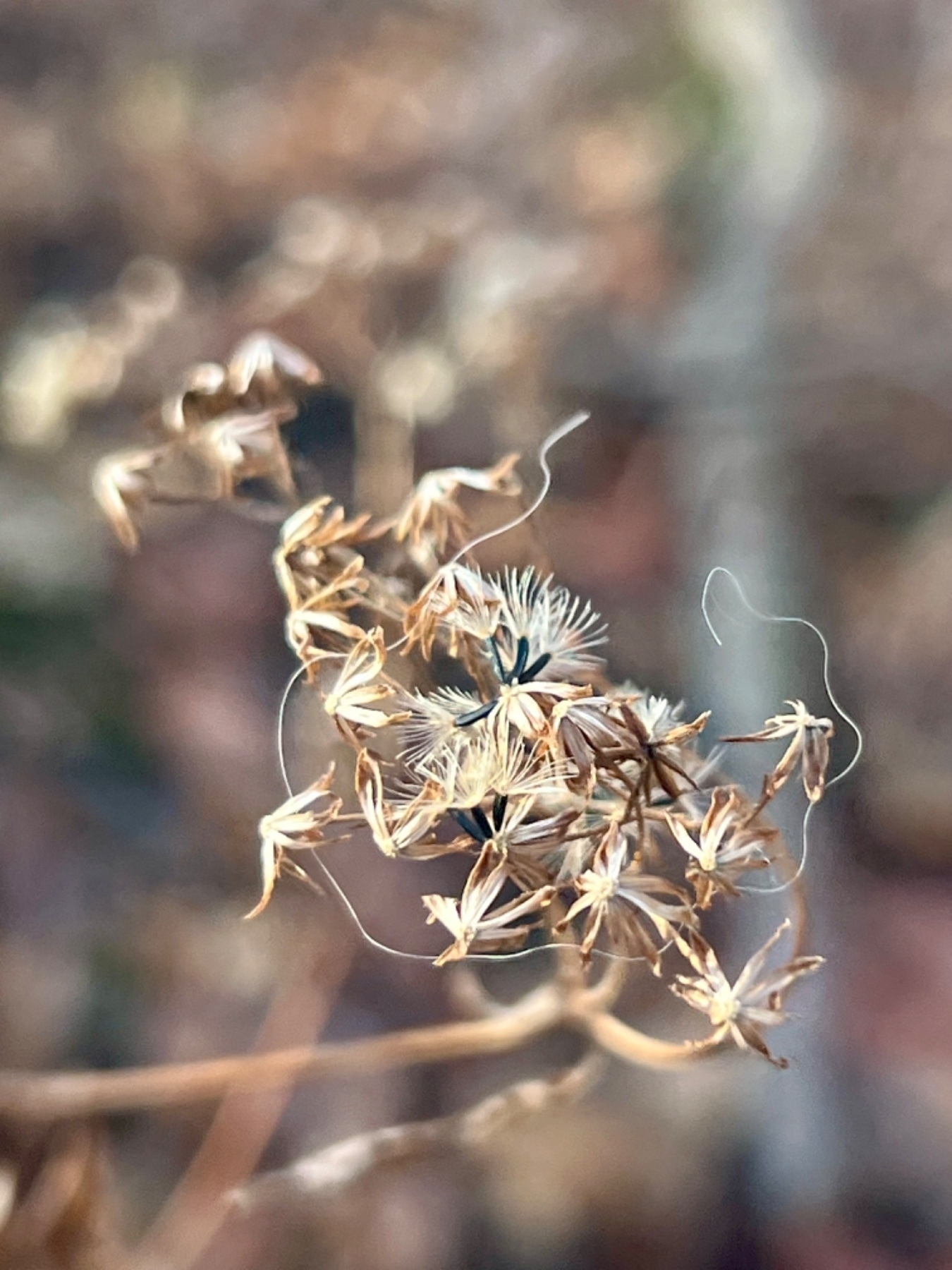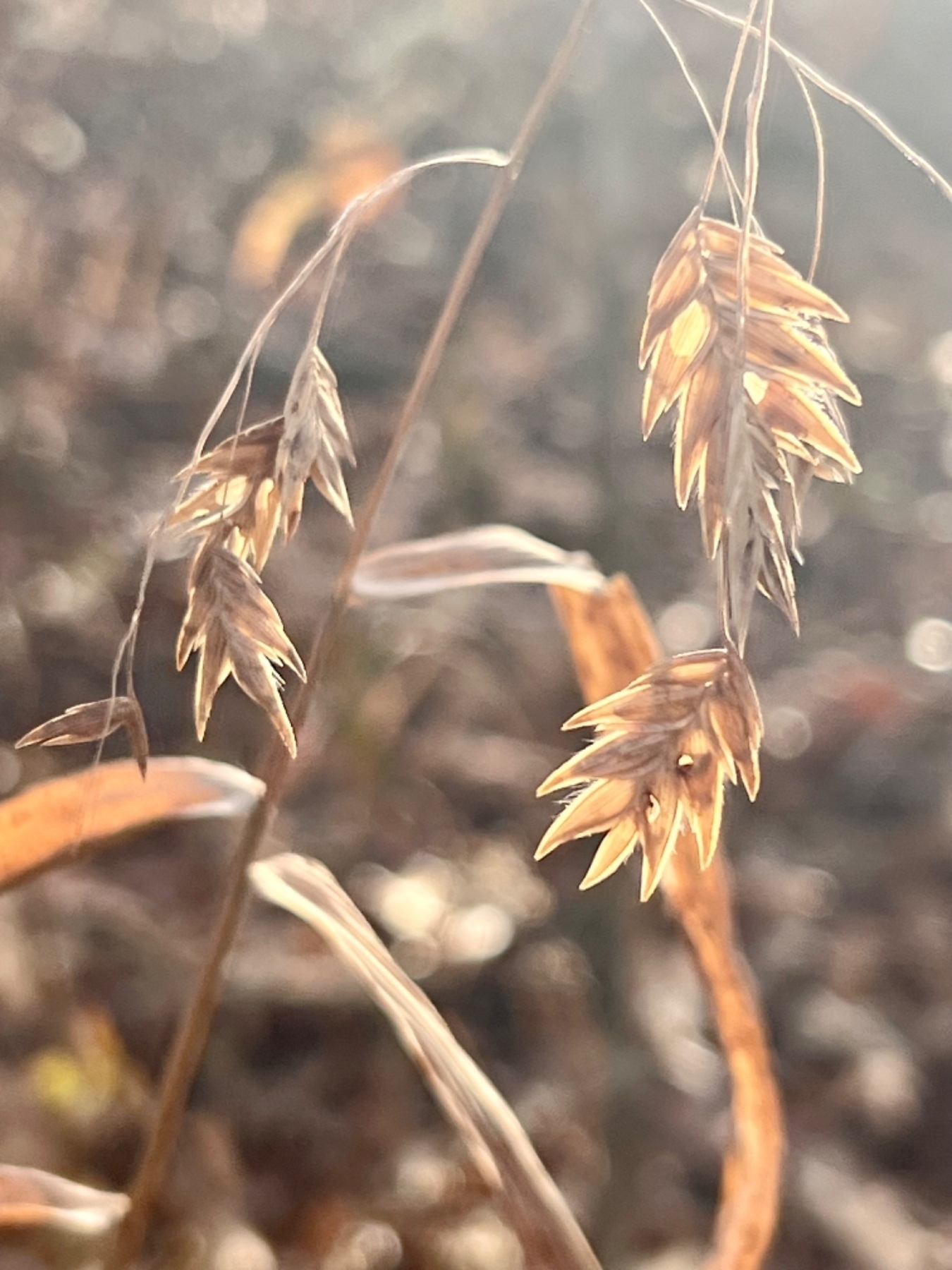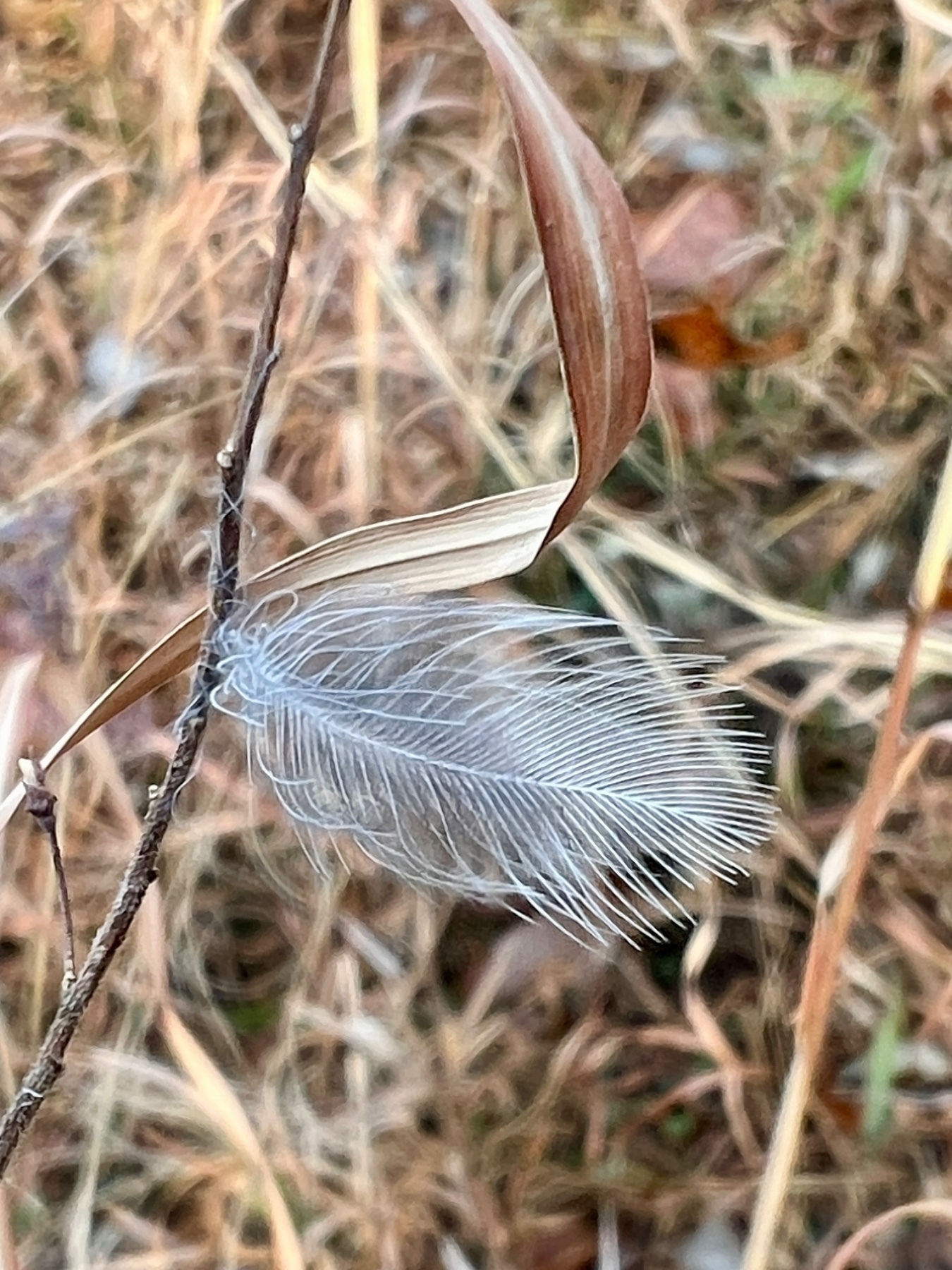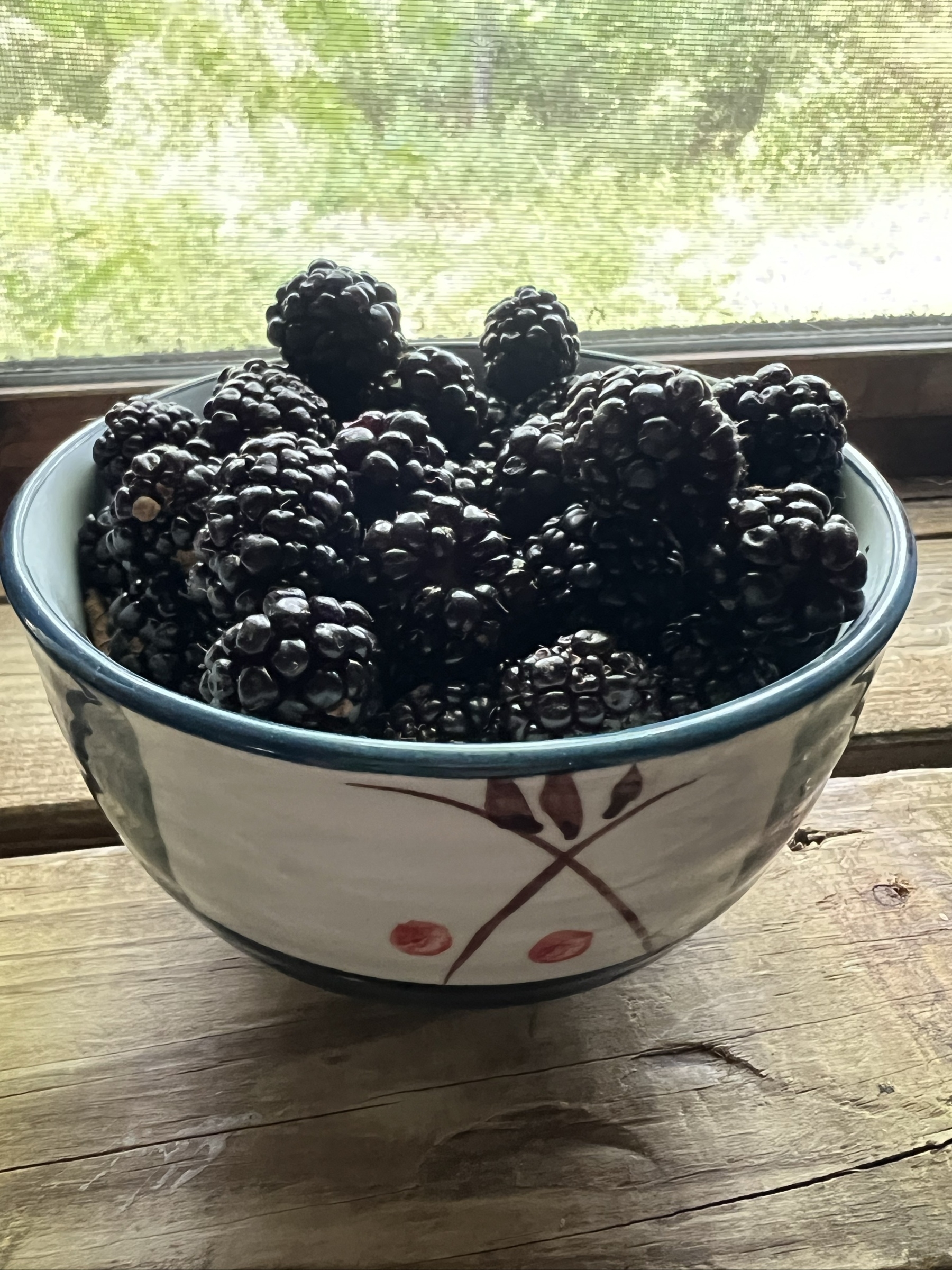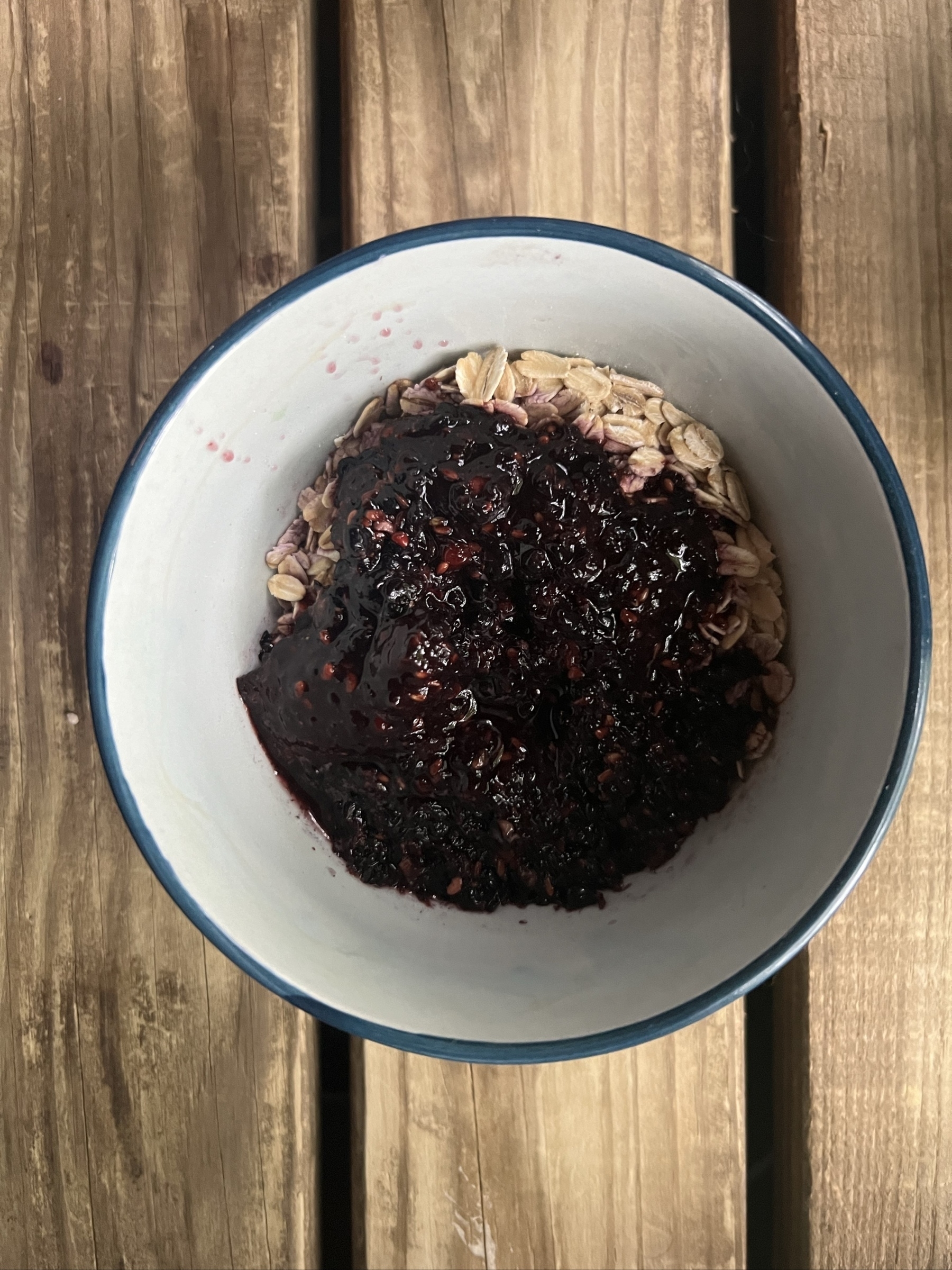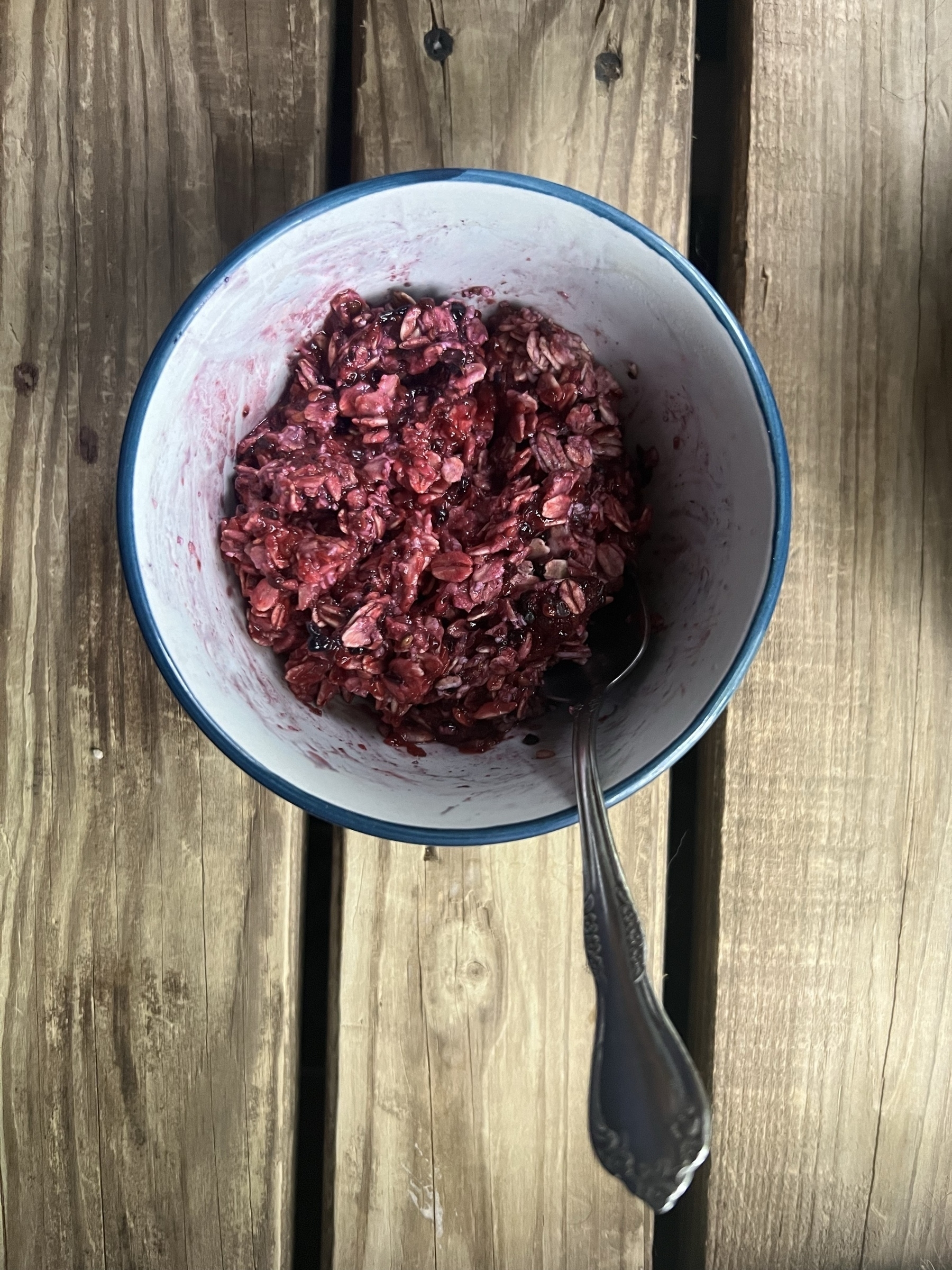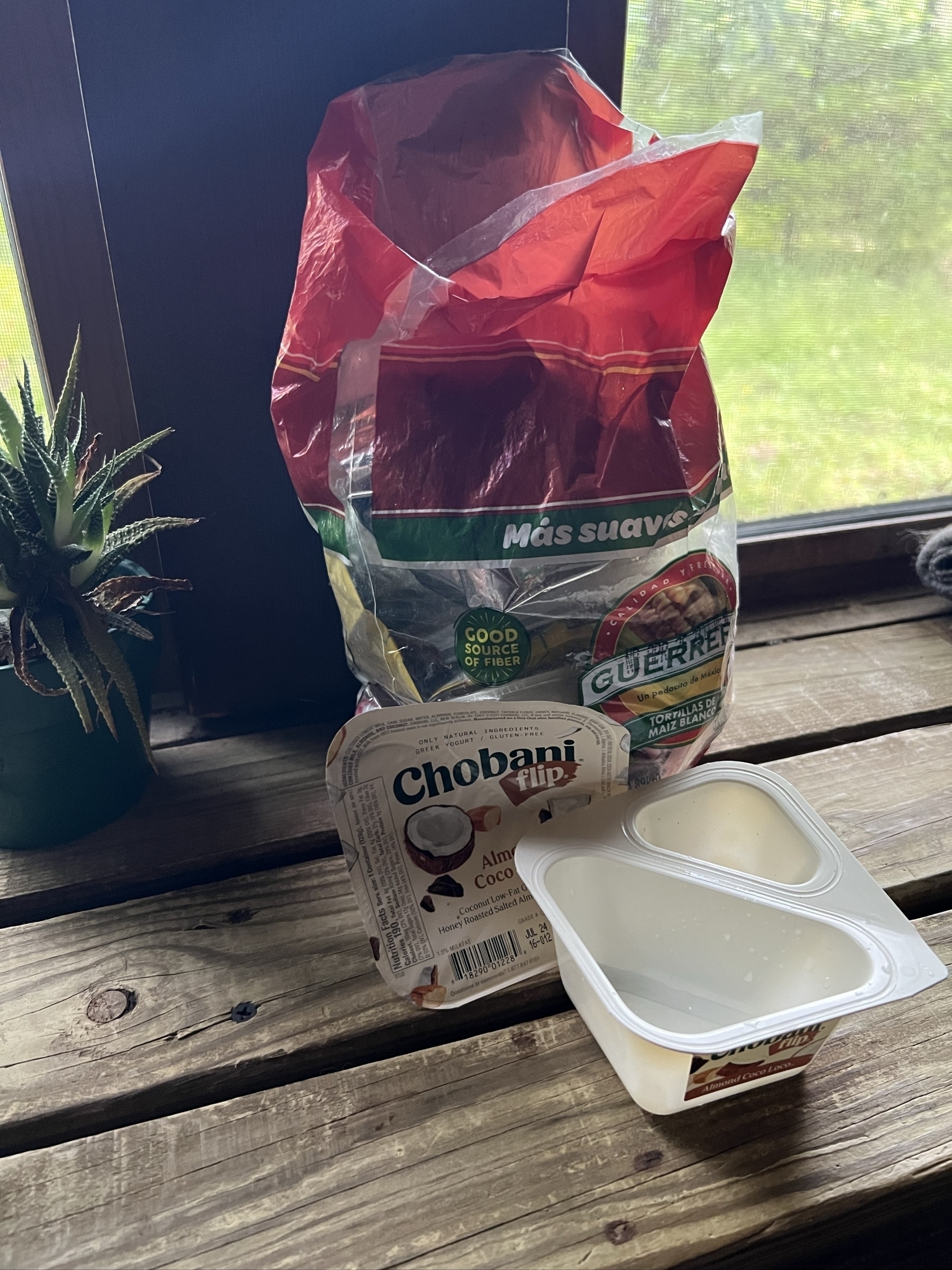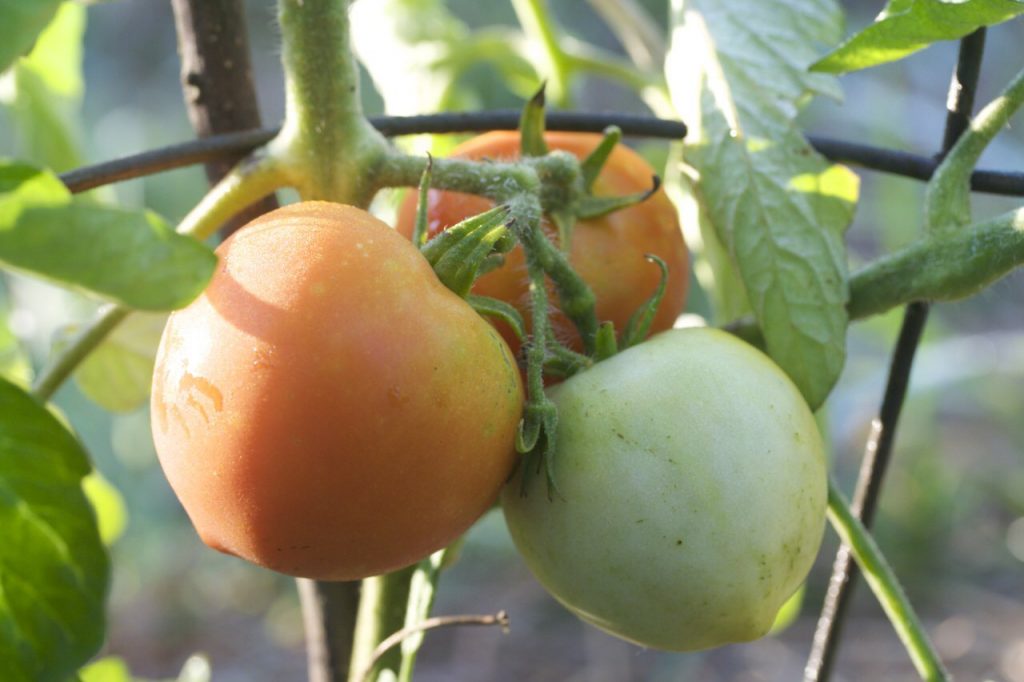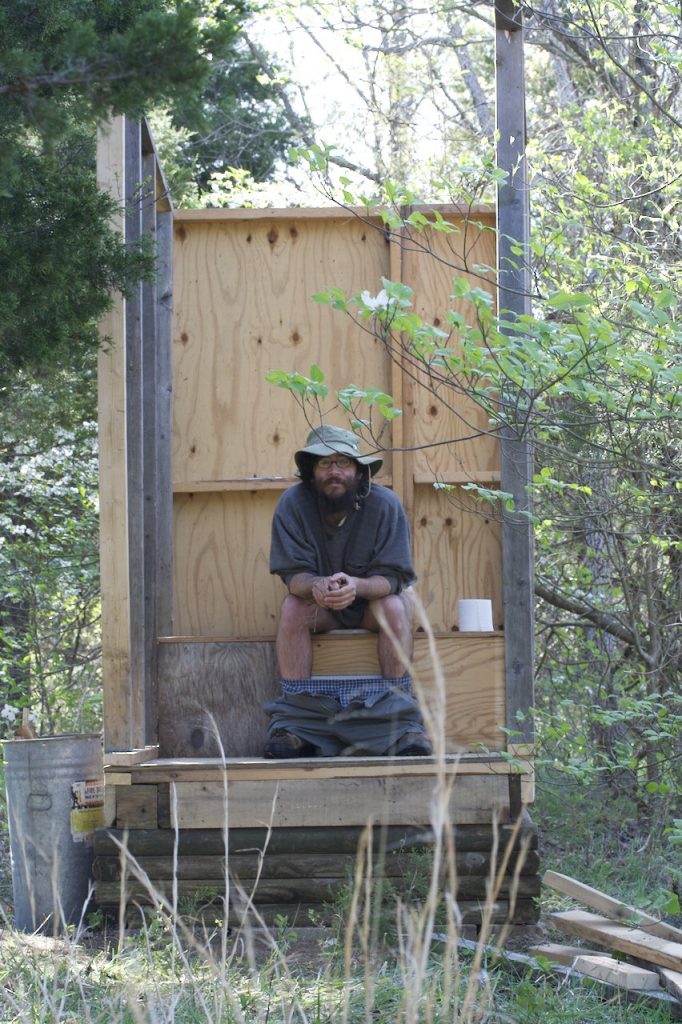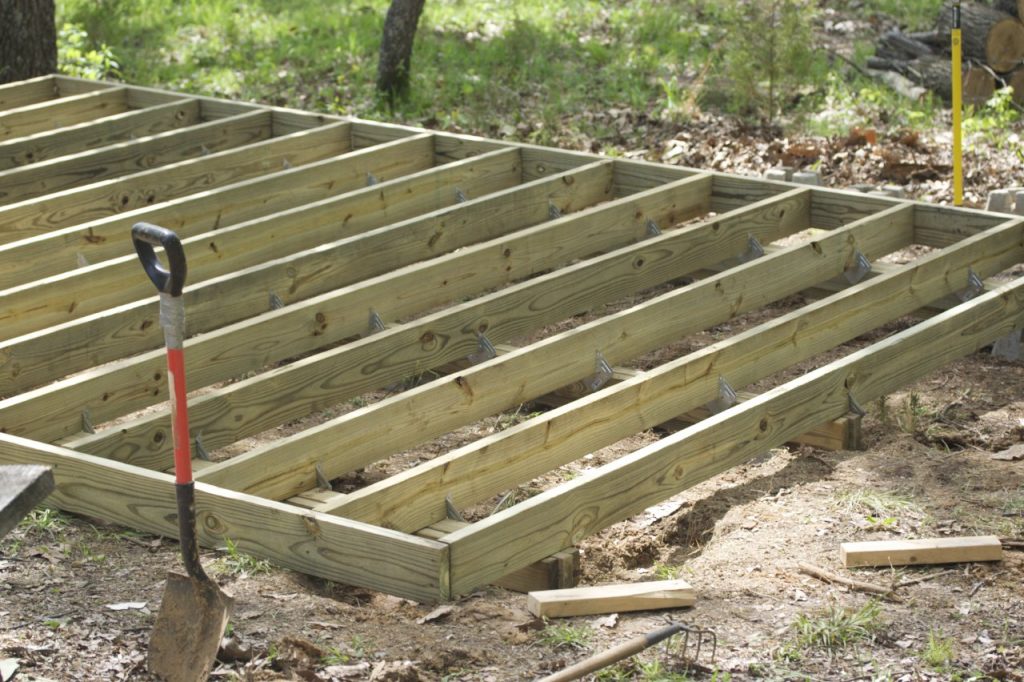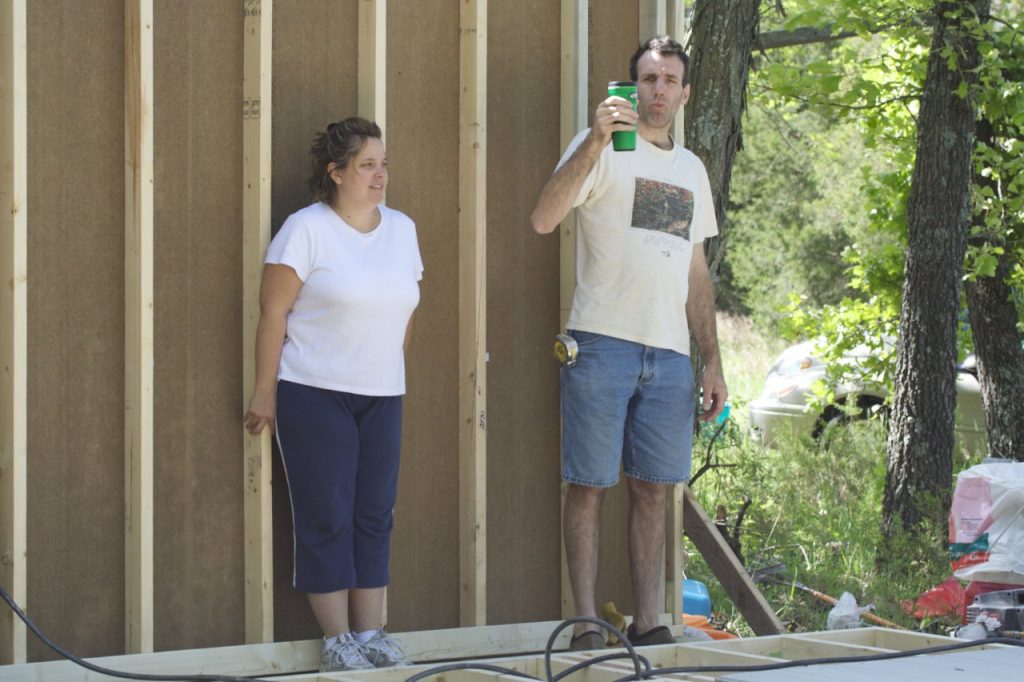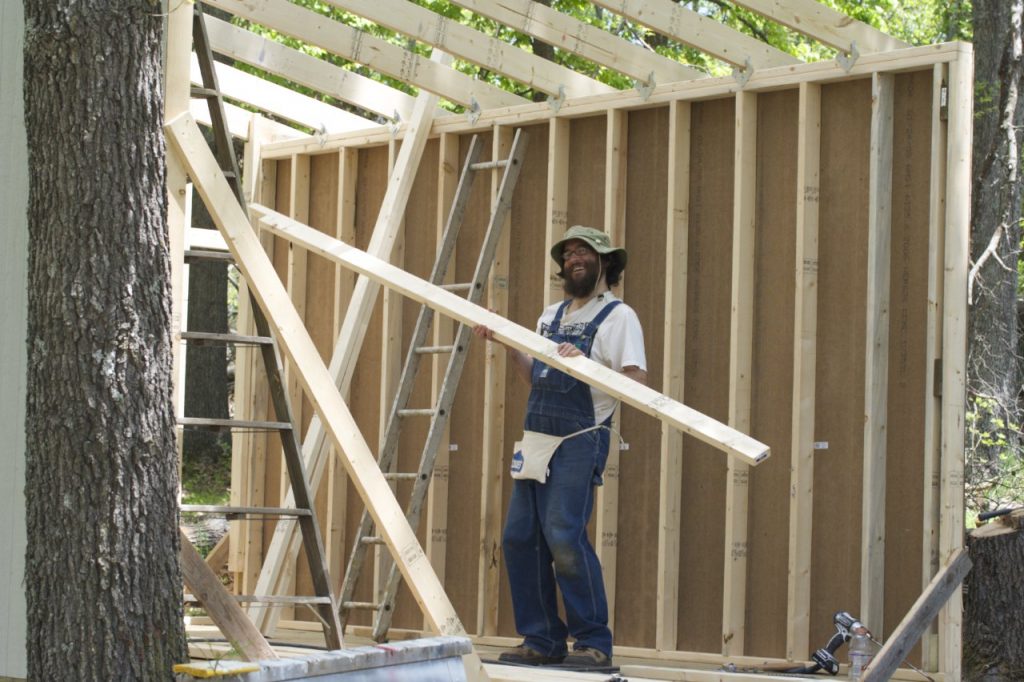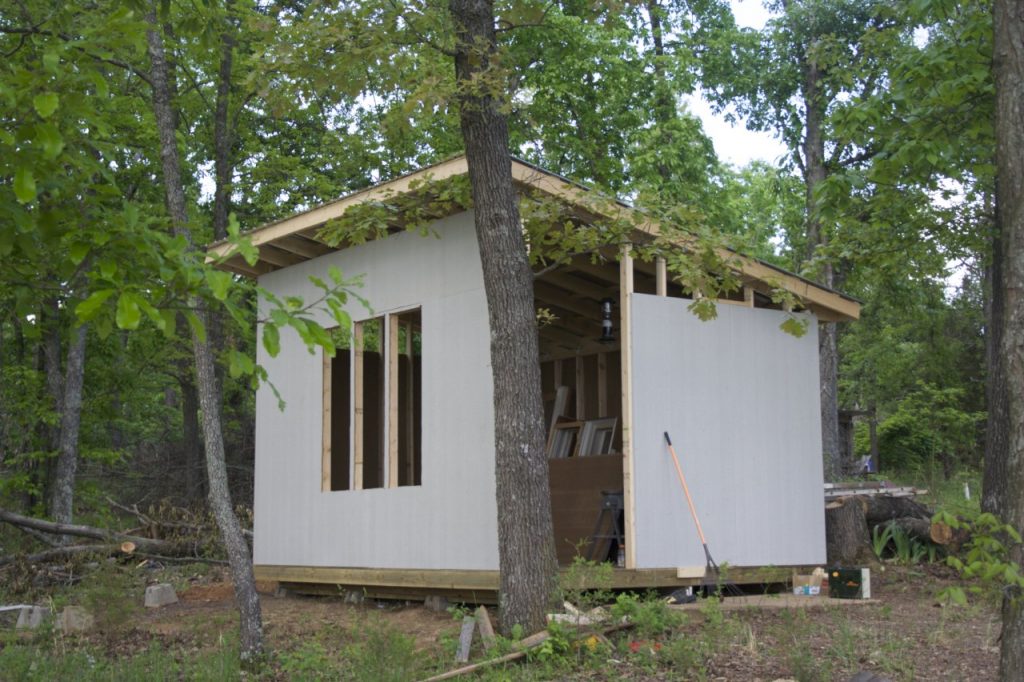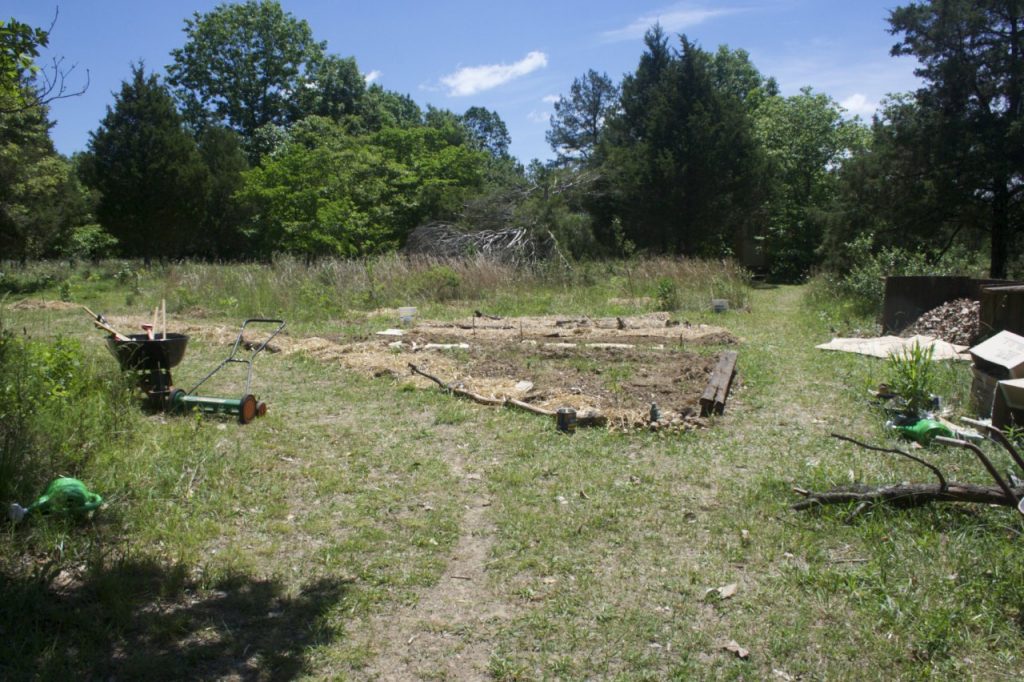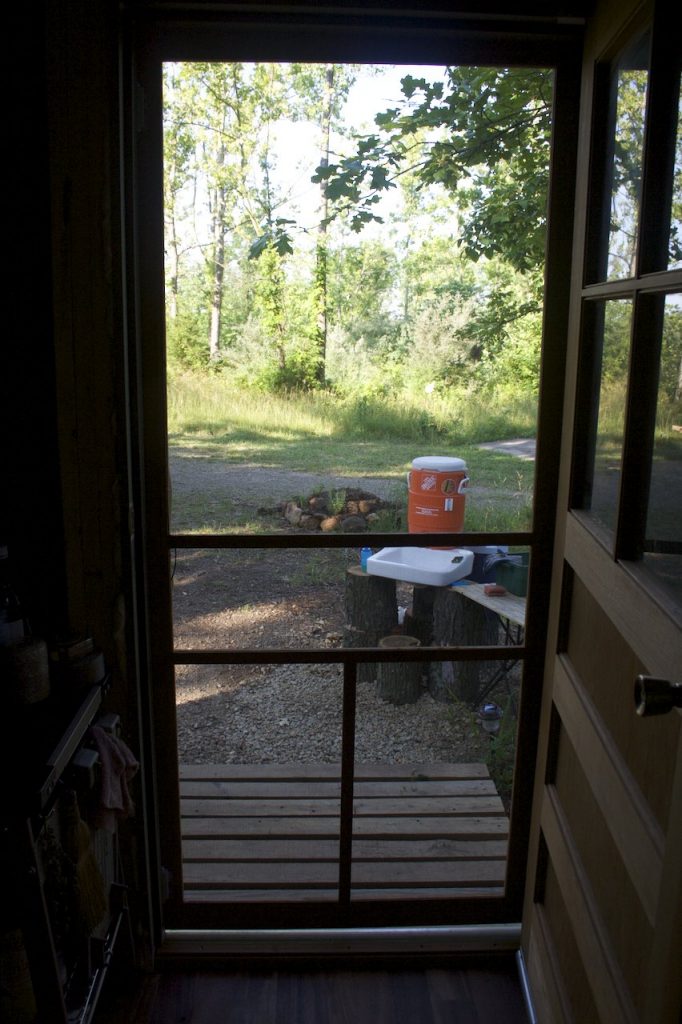Living Simply
- I do own a car but miles driven over the past year are very low at 150. 300 miles over past two years. Only driving necessary trips for groceries/supplies from town. Around 10 trips per year.
- Continue to conserve electricity as much as possible. Example data, it's 55° in cabin this morning. Winter is easier as it's no problem to just add layers as needed. Even at 55-60° I'm cozy and comfortable. Summer is more difficult. Lots of humidity in Missouri but summer temps have been lower than what most have had to contend with the past few years. In any case, as with heating, cooling a smaller space is less energy. I try to keep it between 76-80. Probably averaging 77-78 most days.
- I've not traveled by air in 20 years.
- I have no kids and at 54, single and having had a vasectomy several years ago it's assured I'l continue to not have any.
- My diet is nearly vegan. I do ice cream, occasional cheese, occasional eggs, occasional fish. A note about meat: I don't buy it but if my family are offering fish caught locally I'll eat some of that. Also, if left-over meat of almost any kind is going to get thrown away I'll eat it so it's not wasted.
- I do most outdoor work by hand. As mentioned above, most road work this past fall was with no fossil fuels. My uncle has a tractor and I did help him with his section of road. I worked by hand and helped direct him on the tractor. Surprisingly some things are actually better done with hand tools. I try to minimize grass lawn but I do have some to cut. Also, areas where invasive lespedeza has moved in has to be mowed. I use a battery/electric mower that's charged with solar panels.
- Re-use and recycling. I continue my trend of few to no clothing purchases. Between clothing given to me by folks that are cleaning storage/closets I usually have far more than I need. I've nearly eliminated hard plastic packaging from store bought items. With just one or two exceptions everything I buy comes recyclable steel or in paper or paperboard that I compost. Some food comes in pastic bags (lentils, beans, tortillas) but that's about it. I've recently discovered the joys of waffles made from flour and a waffle iron. I'm not a big bread eater but I'm going to try to use waffes as a bread substitute.
- Take more time eating breakfast
- Make it a point to go outside and get on your hands and knees. Find something tiny, something fragile.
- Observe the processes going on around us, especially those of the natural variety.
- Find nature even if you’re in an urban setting. Seek it out, preferably on foot.
- Plant a seed and make sure it grows. Best if it is something you can eat like a tomato.
- Be okay with being small.
- Think about your use of resources, especially fossil fuels. Reduce travel especially if it requires a plane or auto. Embrace trains and bicycles for travel.
- Reduce your use of resources. Then reduce it again. And again. Don’t stop.
- Increase your capacity to renew life around you. Start small. That tomato plant needs friends. Why not grow a pepper and some basil too?
- Take time to learn about the non-human species that inhabit your region.
- Mulch something. Mulch some of your grass lawn if you have a lawn. Grass lawns are a waste of resources. *Plant fruit trees or fruit bushes.
- Compost your organic waste. Don’t forget to dig into the pile every so often to check out the process.
- *Your tomatoes, peppers and basil are probably a little lonely. Plant some native wildflowers. There’s a bird or a butterfly just waiting to be fed by the flowers you plant.
- Remember, smaller homes require fewer resources to build, maintain, heat and cool.
- Share resources with your friends and neighbors.
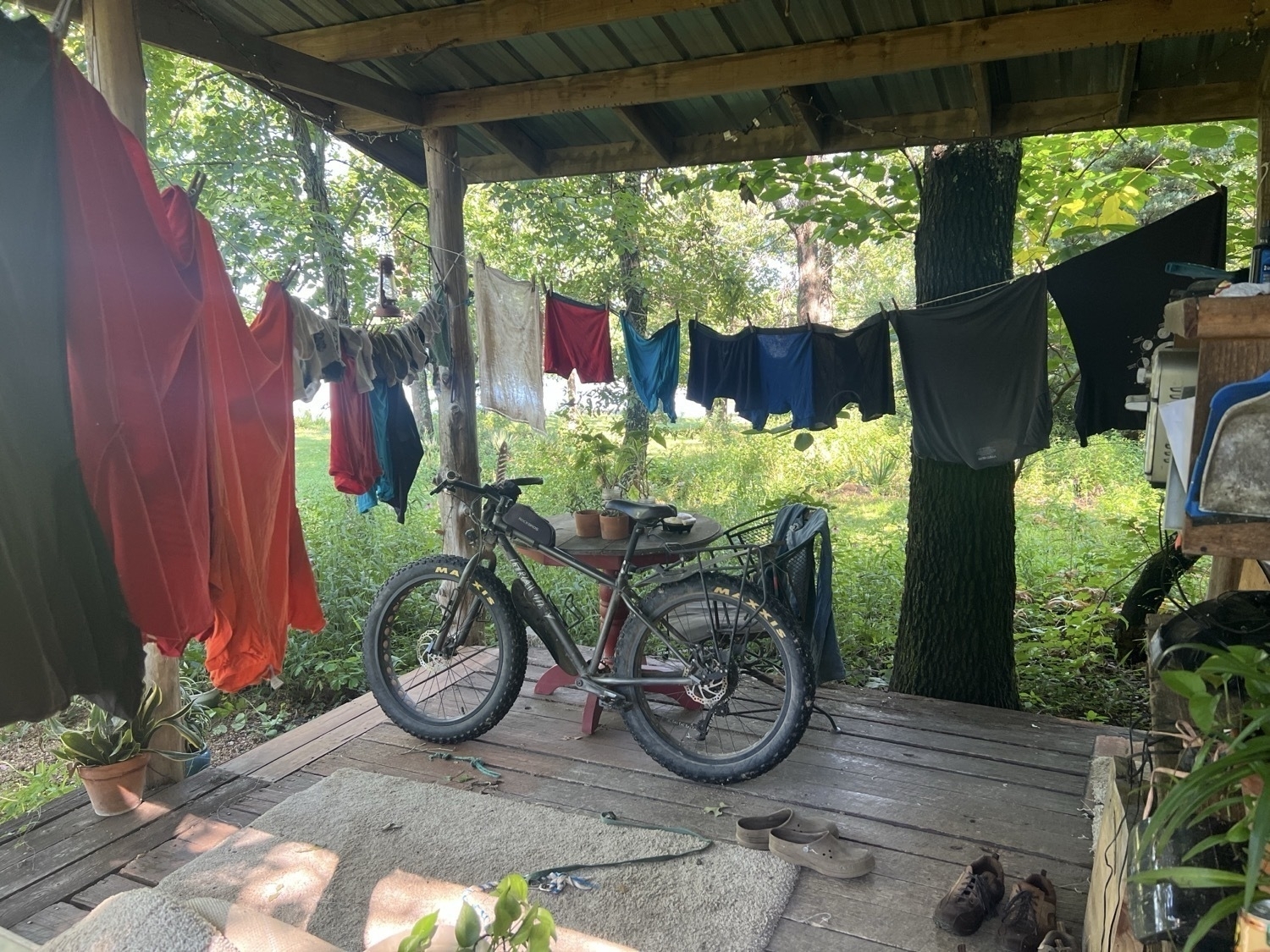
Tiny Life Journal - Laundry day! I don't wash clothes nearly as often as most do. And I keep clothes until they are thin and falling apart. Many of my shirts have holes in them. Also, hang dry is a free, low-tech way to use the sun.
2023 Year in Review (Also, a few interior photos of my tiny house, pardon the mess😂)
My life is generally best characterized as small, slow and steady, I suspect a sharp contrast to most. If you're someone primarily interested in a tech oriented accounting you should skip to the last section. What comes before that is fairly comprehensive and even a bit philosophical in nature. I'm mostly writing this for myself so it's chock-full of details most people likely won't be interested in.
Home and Landscape
I live in a 200 sq ft tiny house that doesn't need much in the way of maintenance or improvements. I often make small adjustments to the arrangement of the space.
The more significant work is spent outside managing various aspects of the landscape. My garden has been small to nonexistent the past couple of years but I still end up spending a lot of time with various projects. This year it was transplanting blackberries and then, later, keeping them alive during a bit of early summer drought. Then daily harvesting in July.
In late August after a third extreme rainfall event and increasing run-off damage to our gravel roads I decided to take care of some long over-due maintenance. As I don't have a tractor this was my daily exercise, 1-2 hours a day. When I started I was unsure of the scope of the work. My intent was to start with the most problematic 40 feet of road and if it went well to continue on to another section. That first section went very well and I had it completed in 4 days. I ended up working on the remaining damaged sections through early December. I'd estimate 90 days averaging About 1.5 hours a day. It went very well. Various sections of road and driveway are much improved and the exercise generally felt very good. There's more to do but I'm taking a break now that it's gotten colder and the road is somewhat frozen.
Another fall project was clearing out several years worth of growth around our well house. I live in the woods and love it. I'm not in the habit of aggressively cutting back trees, shrubs, vines unless there's a reason to do so. This fall some new forest critters decided to make their homes in our shed and well house. Wood rats! These are about the size of squirrels but without the fuzzy tails.
I started noticing nests and food caches of acorns and wild grapes appearing in both my shed and the well house. I removed them and started taking steps to remove any sense of comfort my little friends had in these spaces. I decluttered the shed and made a point of just being out there a bit for a week. It's an old shed, somewhat open to the environment. Not sealed off tightly. My strategy worked.
The well house was another situation. Autumn olive bushes, wild grapes and honeysuckle had crept in all around the well house. The thick growth right up to the building was perfect for my friends. Food, cover, and nesting material. I don't spend much time in the well house but check it in the fall to prepare for winter. That's when I discovered my friends had started moving in.
It prompted me to take a closer look at the building and the surroundings. Where previously I'd seen the approaching mini-forest as a welcome wind break and habitat for birds (hummingbirds like to nest in the thick growth) I now had to reckon with the fact that it was also habitat for these new neighbors that were very determined to get inside the building and build nests. I sorted out their various access points and started patching old wood they had chewed through. And during the same couple of weeks I began, reluctantly, cutting back all of the growth of the mini forest. It took about three weeks in total. I cleared the area, patched the walls, sealed the outside of the building around the crawlspace.
A final part of this project was tearing down the original, still attached mini-well house structure that had been built by others many years ago. It still served as cover for our well head and the piping into the well house. I removed that and built a much smaller structure using some salvaged wood and windows. It looks a bit like a tiny A-frame greenhouse. It will serve for this winter and will likely be replaced next year as I suspect that the larger well house is going to need some significant work.
Health
I'm still dealing with some sort of inner ear issue that began with a severe, daylong episode of vertigo in September 2022. Without a doctor I've self diagnosed as some sort of Labyrinthitis. The general cause of that condition is bacterial or viral infection. Treatment seems to be centered on steroid shots and vestibular therapy. Generally the advice is to get on living life and allow the brain to adapt. Over the past 15 months it's gotten better allowing me to do normal day-to-day.
Another symptom is tinnitus which I counter with background audio from the DarkNoise app playing 24/7. I've found a pleasant mix of crickets, creek and frogs helps a lot. The crickets are the key frequency/pattern, the frogs/creek are just there to create a pleasant background.
Other health, once I got past the first three months of intense vertigo I was able to get back to my normal routines of daily dog walks and even short 20-30 trail rides on the bike. Strangely I notice the vertigo less when riding the bike.
A last health note, I've had to be much more attentive to drinking enough water and salt intake. I've probably always taken in too much sodium and not enough water. Noticed high blood pressure a year ago. Careful now to drink a minimum of 70 ounces of fluid a day and generally have sodium intake down to 2,200 mg per day. BP has returned to normal as a result.
I'm very happy to have gotten into the habit of daily diet tracking via iPhone app as well as exercise tracking with the Apple Watch. Both devices/apps have been very helpful in making sure that I'm being honest with myself about keeping a balance.
Personal Climate-Adaption
I've been on this one for a long time but have gotten even more restrictive with myself the past 3-4 years. I'm well aware that my singular efforts are irrelevant but I do it because I believe that if we humans had solidarity with one another and the planet we could fix this problem by common, collective action. Government or no, we could fix it by helping one another live differently. So, I'll keep talking about it, encouraging others and at the end of each day I know I've acted as though we were all working together.
The top 5 cuts to make (according to data) are ones I've got covered pretty well.
Working for income
I continue to have a love-hate relationship with money. I love to hate it. But as a human living in a capitalist system I also need it. I continue to generally live far outside what is normal in terms of work and income. I was thinking about climate, biodiversity and other environmental problems in 1990 when I was 21 years old which was around the time I rejected any idea of going after the American Dream. With no kids and a very tiny dwelling I have fewer expenses. Add to this my general frugality in pursuit of limiting carbon and waste and it means I can get by with far less than most.
My freelance work continues per the usual though in recent years I've had far fewer requests for new websites. Most of my client-work is maintenance of a websites as well as a mix of document layout/design and data/spreadsheet entry. In general, slower but steady.
Tech
My tech purchasing this year was minimal. My AirPods Pro died after 3 years of use so I replaced those. I also added a small 15" portable display. My intent was to use that as a second display for the iPad when I'm working from the futon. It proved useful not only as a work-related display but I've also been using it with the AppleTV. I also added a new keyboard and mouse, both are working out very well.
I have an older LED TV for movies but I've not been using it much. As I've gotten older and my eyesight worsens I'm finding I prefer a closer screen for entertainment purposes. The reason being I also browse the web with my iPad while watching some things. The TV 10 feet away requires my glasses but reading on the iPad requires that I take off the glasses. A second display within a couple feet allows me to watch and browse without glasses. I suspect I'll be trying to find a new home to donate the tv to later this year.
In recent days it also occurred to me that I could reposition my 4K computer monitor. It was positioned at my desk but the truth is I don't sit at the desk that often so it generally goes unused. On a bit of a whim I repositioned the arm and lowered it to one of the shelves closer to my futon. It's a bit odd having such a big screen (27") so close to the futon but in a week of use I think this is where it's going to stay. I've got it hooked up to the AppleTV for movies/TV. Or, if I want to use it as a second display for the iPad I just plug in a USB C port that goes through a hub to the monitor. When not in use it is swiveled out further away from the futon.
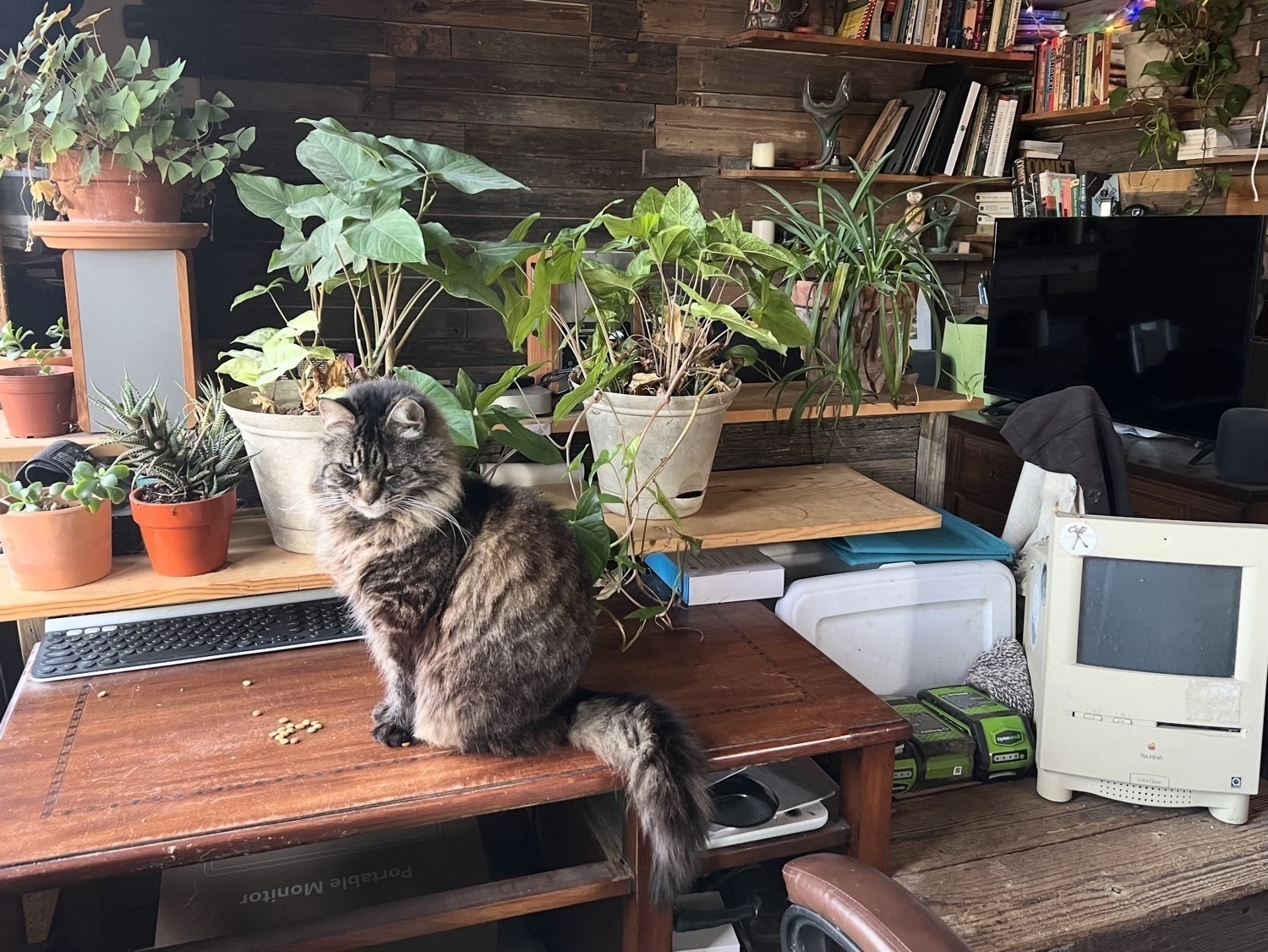
With these changes my small desk has more plants around it and is Rosie's dog-proof feeding area. The Mac Mini that is my file server/iPad back-up is in the same place and can be used with the monitor in its new location. The Mac Mini sits on the shelf/mini-wall between my desk and futon. My whole set-up is a bit weird but I attribute that to the fact that it's a one-room tiny house. It's nice though to walk into the cabin and see plants rather than a computer monitor.
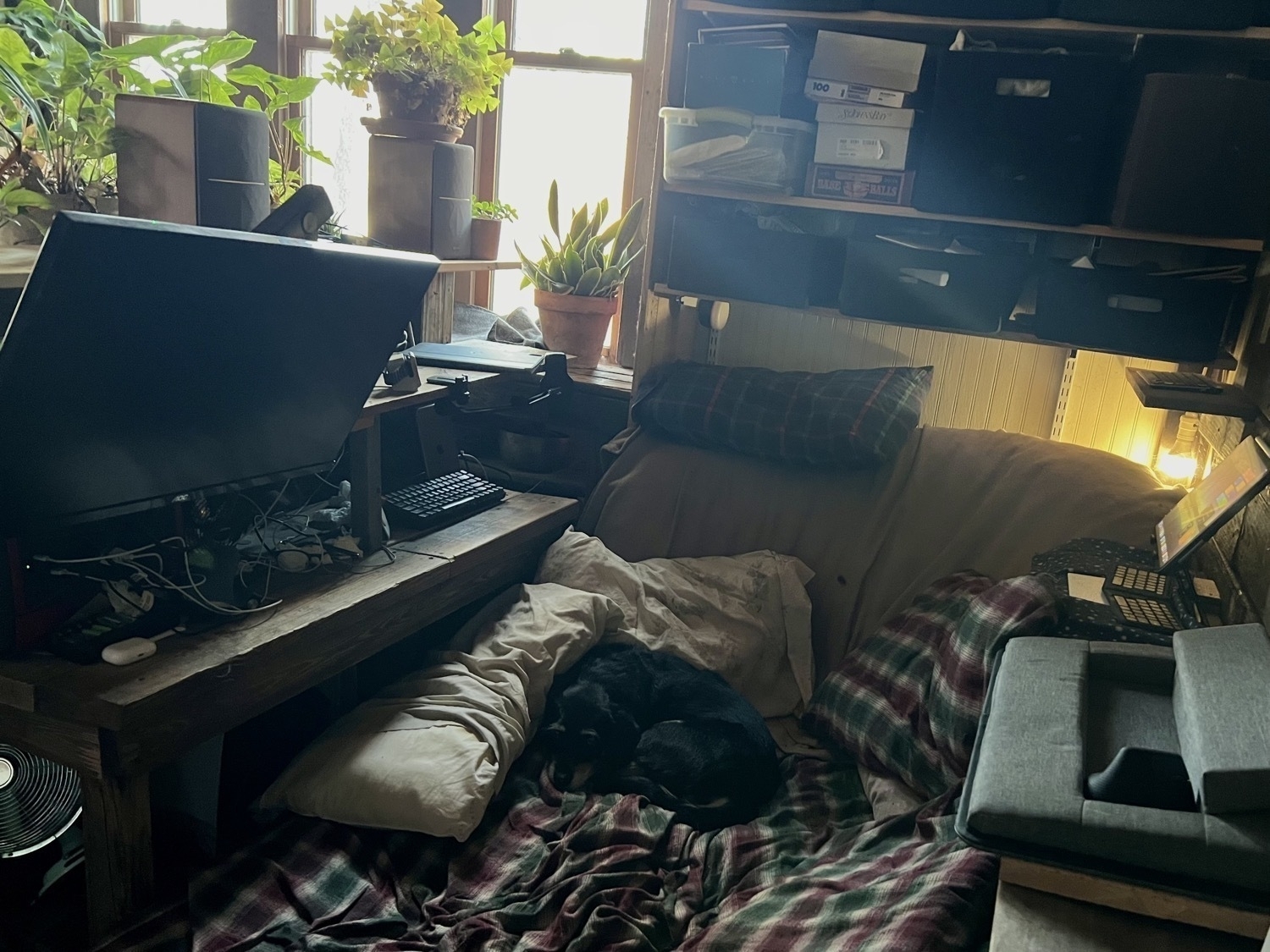
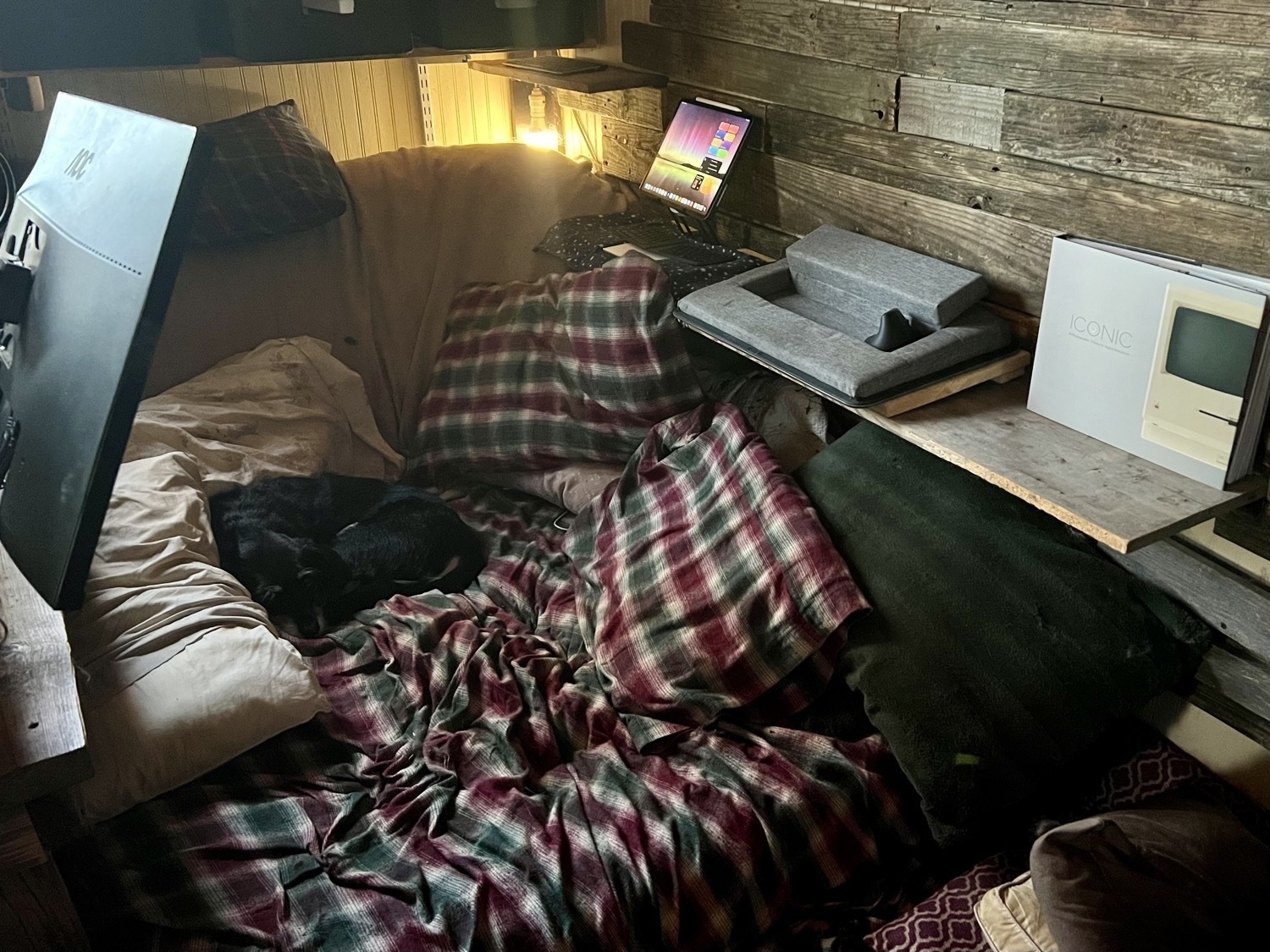 Some amazing iPad hardware is coming from Apple soon but I intend to stick with the M1 iPad as it works very well for what I need. It's only 3 years old this spring. It will likely need a new battery later this year.
Some amazing iPad hardware is coming from Apple soon but I intend to stick with the M1 iPad as it works very well for what I need. It's only 3 years old this spring. It will likely need a new battery later this year.
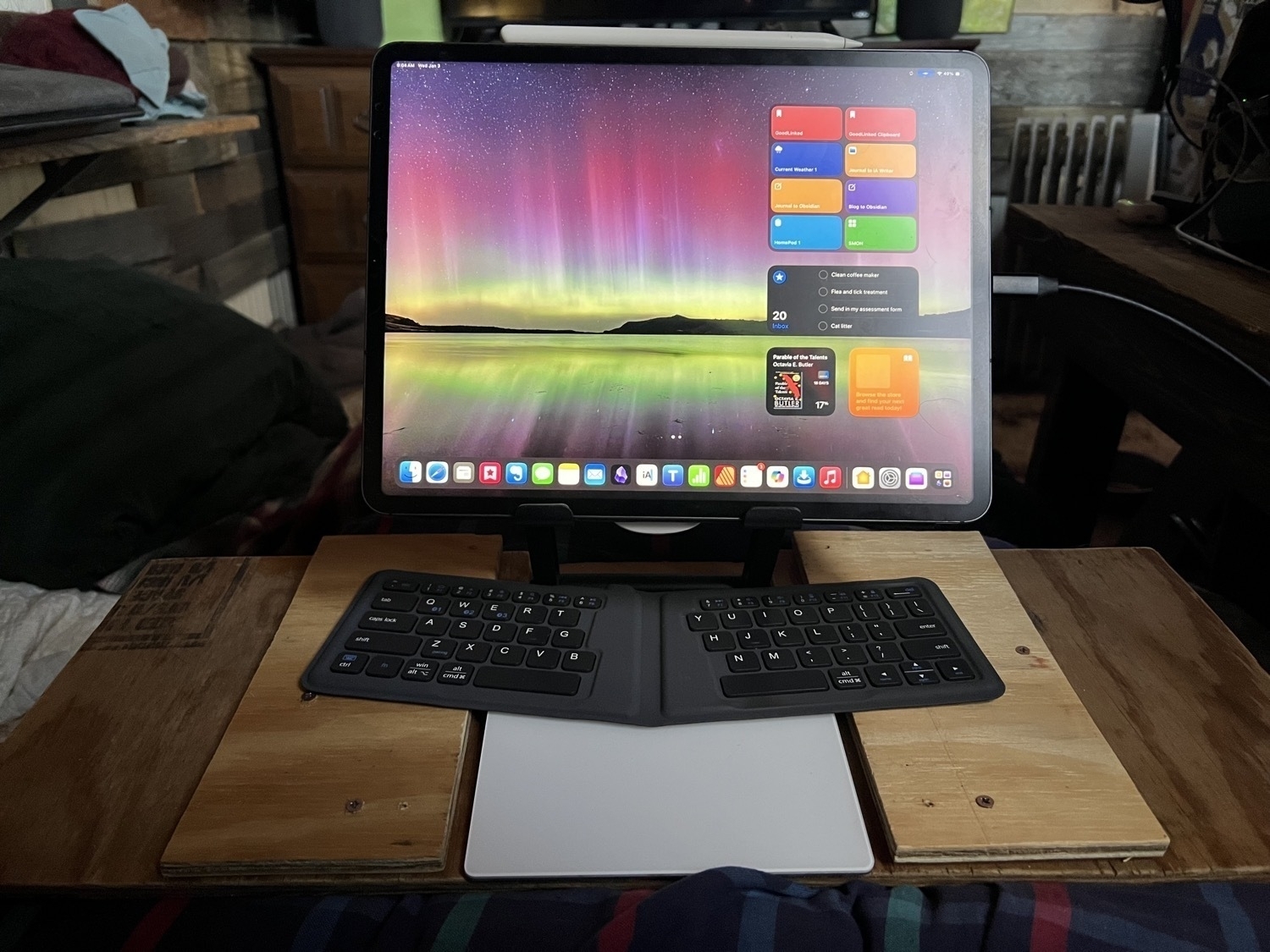
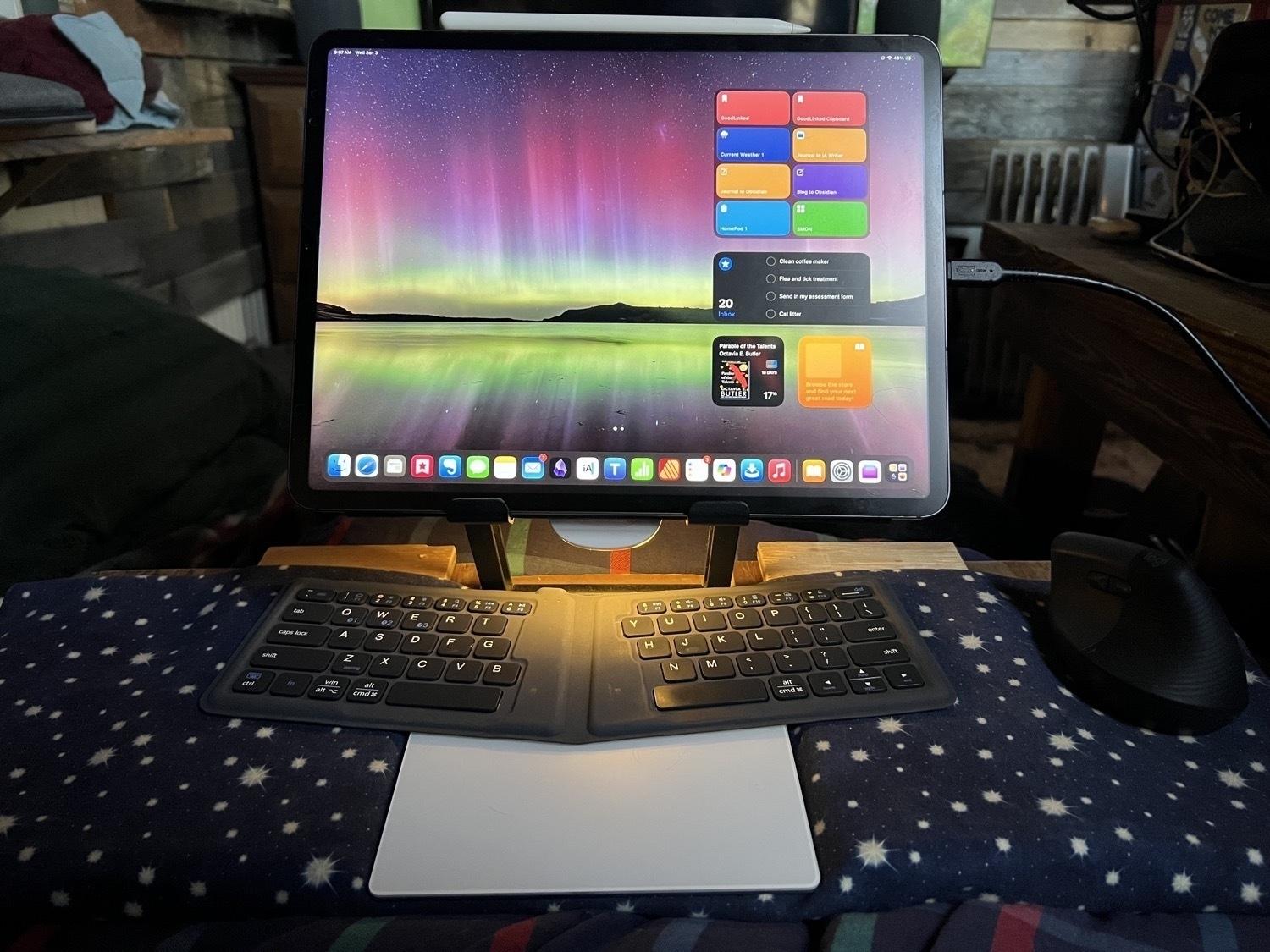
Over the past year I’ve enjoyed my various and ongoing configuration experiments. Just yesterday I modified my lap stand so that I can easily center my trackpad below the keyboard. By adding two small sideboards it’s now a recessed trackpad. Works perfectly and there’s plenty of room for the mouse to the side. In use I keep a pillow case on top for comfort.
Between this stand arrangement and having the adjustable shelf-clamped stand I have a variety of choices. A side benefit of this regular experimentation is that my set-up is fun and never feels stagnant.
My iPad Mini 5 and iPhone 13 both continue to work well and I expect to get at least another 3 to 5 years from both. The responsible thing is to use all of this hardware as long as I'm able and that's the plan. I want to appreciate not just the resources each device embodies but also to appreciate a kind of connection that comes with using a tool for a while. I expect I'll be able to get another year from my Appe Watch 4.
Among tech enthusiasts it seems fairly common these days to trade up to the latest, greatest fairly often. And so these valuable, powerful computers are being treated like disposable goods. Really, it's something that only a minority of the wealthiest and most privileged of humans can do and it's irresponsible. But also, it doesn't allow much room for the nostalgia that comes with long-term use. My 9+ years old iPad Air 2 still works and is put to use to run the DarkNoise app and occasionally for photo slide shows.
All that to say that I've been very happy with the over-abundance of computer/tech hardware that I have.
Image of one corner of the interior of my tiny house, 2024-01-03.
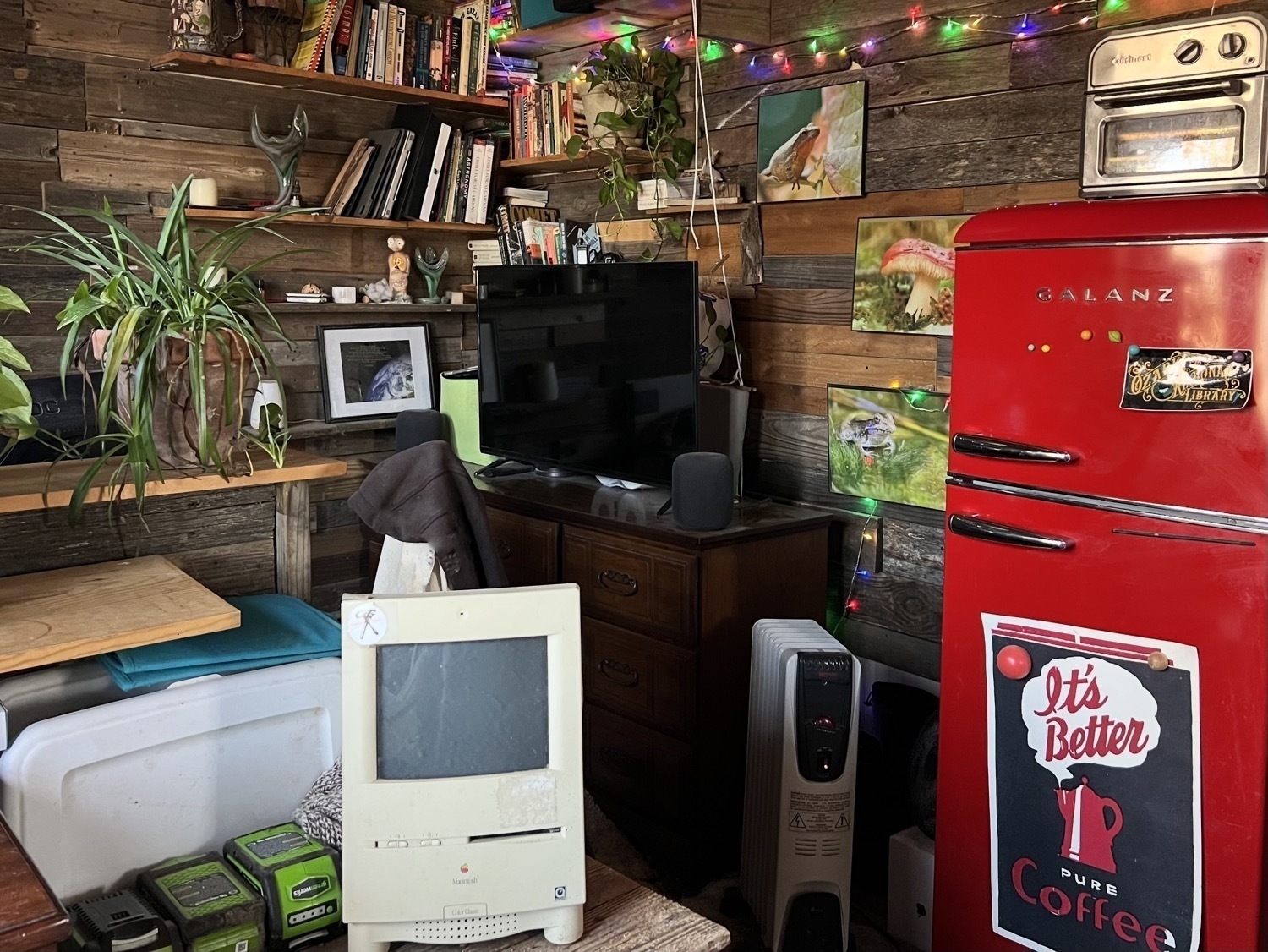
Over at Mastodon Jason shared this article about living a simple life. The post offers up some helpful, worthwhile suggestions about being more thoughtful in life choices in terms of the usual practice of keeping up appearances, consumption-based living, etc.
I looked at a few other posts from the site which offered similar good advice. But it is the packaging of minimalism and simple living that has become a bit of a meme on the internet. And while such sites might serve as an introduction to questioning consumerism as a way of life they often have something to sell. I wasn’t too surprised to see that, indeed, these folks offer a paid course. Even the simple life has a price. 😉
But yes, it’s increasingly obvious that our modern way of life is putting strains on our mental and physical health as well as on the ecosystems of the planet. In the developed nations the top 10% have built a way of life based on hyper consumption of resources which requires constant work and a focus on income. For many the vision of the “American Dream” is playing out as something else entirely.
We’re living in a time of persistent crises. The climate crisis serves as the background and it alone represents an existential crisis. But on top of that there are many others that surface as a result of the world we’ve built. The “simple life” and “minimalism” offer up a glimpse of something else. They hint at a calmer, quieter life with reoriented values like time spent or experiences a relationships rather than stuff. On the surface this sounds good because want to feel better, we want relief from the crises of modern life.
But let’s not just go for relief. Too often our drive is our physical and/or mental comfort and often that means a quick fix or band aid. So, let’s not just stop at the notion that our problem is too much stuff. Yes, acquisition of too much stuff is a problem but really, it’s also a symptom of a deeper cultural problem.
Let’s dig deeper.
Capitalism is the basis of modern, western nations. For decades it’s been sold as congruent with democracy, almost as though it is the other half of democratic society. It’s been assumed by many to be normal, natural and the way that economy should function. Certainly this is the commonly held view in the United States. But at the base of capitalism is insecurity, the never ending drive for increased profit through increased growth and consumption. These are fundamental, foundational to the “American Dream”.
The problem with simple living and minimalism as commonly discussed is that they serve is a temporary balm but leave us with problems. And so we just continue in long crisis. We experience it personally as perpetual longing for the unknown thing that we think will help us feel more secure, happier, content. It’s always there over the horizon. It’s to be found in documents like the US Declaration of Independence: “Life, liberty and the pursuit of happiness.”
Happiness. Dare I say that perhaps a part of our problem is our focus on our happiness? It seems normal enough, to want to be happy and to search for what makes us happy. But happiness is ephemeral. It’s not a permanent state. And we live in a time and culture when it’s a fairly common message that what brings us happiness is the purchase of that next thing. Or, even, that next new experience. It might be a concert, movie or a trip. But no matter what we consume, the “happiness” is fleeting and within hours or days, we’re onto the next thing we want.
My suggestion is that we consider shifting our focus away from our pursuit of happiness. And don’t get me wrong, it’s okay to be happy, to experience joy. But I would suggest that we need to go deeper in our search. That it would be more helpful and meaningful to ask other questions. To begin, what is our purpose as humans. How can we contribute to the well being of not just our families but our communities? Will our life on the planet leave a it degraded or even severely degraded to the degree that future life will suffer?
I’m not going to claim to know all of the questions we should be asking or to have the answers. But, rather, that we should be asking more of ourselves than we have been.
I’d like this to be a series of posts because it’s the kind of exploration that can and should branch off into side explorations. For example, what is the result of a culture that encourages a focus on the nuclear family as many of the wealthy nations do?
Thinking living simply, there are practical considerations of how we think of exercise and physical labor in a time when many work in offices. Which is a subject can then branch off into the tools we use and how they may be measured in terms of longevity, repairability, carbon footprint, and requirements for use.
There’s a lot to explore and I’m planning follow-ups.
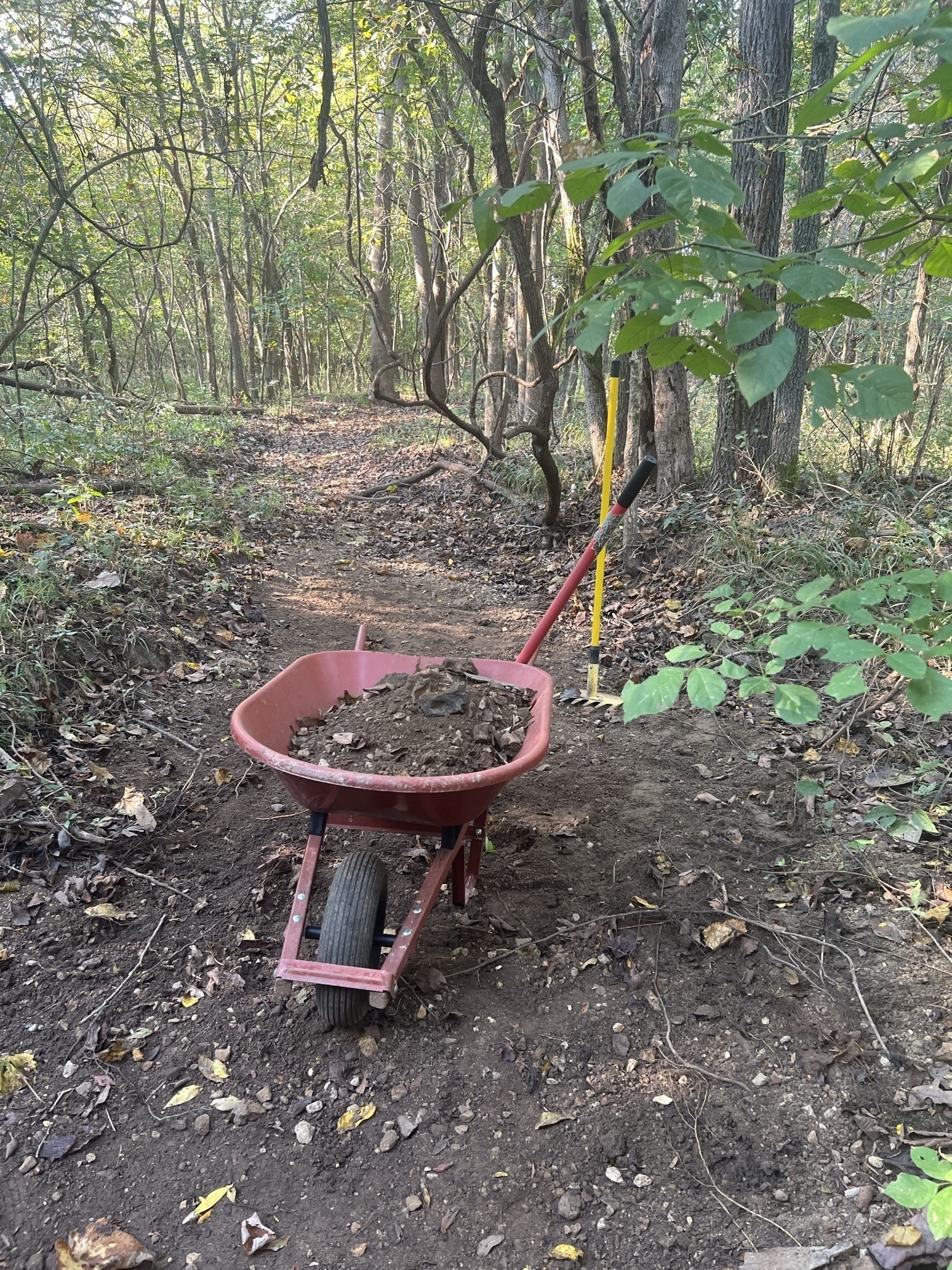
I'm not doing the Micro.blog September photoblogging challenge but thought I'd share a photo for today's Date in the life. For the past 22 days I've been working on our gravel road. Moving 5-8 wheelbarrow loads a day from our dry creek bed to fix a few washed out sections. 100+ loads total, 2+ hours of daily exercise, about 1,100 cal burned as a workout. I like getting actual, needed work done as a workout. Several more sections to fix, another few weeks of exercise. The road actually looks messier because now its a mixed up conglomeration of the original, uniform gray road gravel but with lots of dirt, sand and creek gravel all mixed in. In the process of digging out the shoulders to resurface the burried gravel, adding the creek materials I've raised the whole section of road an inch or two while also lowering the shoulders for better drainage.
Obviously working with just hand tools takes far longer than using a tractor or other motorized equipment but I need the daily exercise anyway. 2 hours a day spent listening to music and working out in the woods to fix a problem makes sense. With two hours a day through September, October and perhaps a week or so into November I should have it done before the ground starts to freeze.
Over the past 3-5 years we've been getting more intense, 7+" rainfall events each year. With each such event more excess gravel is left in the creek while more of the road gravel is washed off the road. Going forward I'll have to spend more time maintaining it but the work now should result in a more stable road and also better divert the excess water during storms. The goal is to have more water shed off the road rather than flow along it.
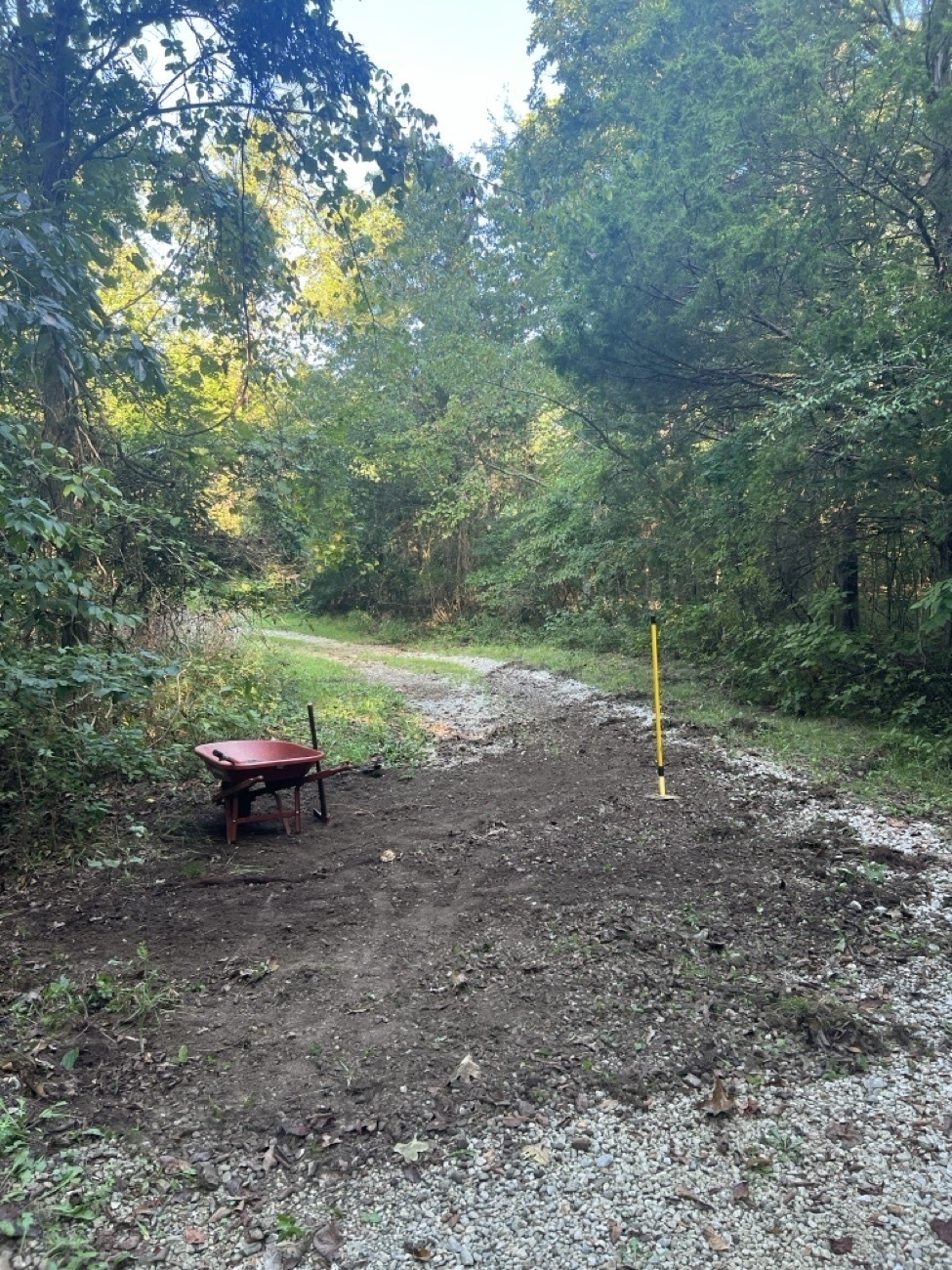
Over time a gravel road used by heavy vehicles will deform. The weight of cars and trucks will crush rock into smaller bits as they also push gravel to the outer sides of the road forming raised areas in the center of the road as well as raised shoulders. As the tire tracks slowly deepen, gravel being broken into smaller bits water begins to do more damage.
Add to the scenario a hill that sheds water to the road and a creek that floods and now you've also got extra erosion as water channels down along the tire tracks in the road.
In recent years I've watched as flooding due to more frequent 7-8" rain events do more damage to our private road each time. It's a project I should have taken on sooner. I don't have a tractor so all this will be done by hand using a few tools. It's a lot of work but I consider it my daily exercise. Though the final result will take much longer to accomplish it will be done just as well and with zero carbon emissions. And I'll be healthier for the exercise.
Broken down into 1.5 to 2 hours per day this section of road will take me 5 to 7 days, 10-13 hours. The photo above was taken after about 3 hours of work. Each workout has my heart rate average at about 140bpm which is equivalent to a moderate effort bike ride on the trail. Perfect.
The general idea is to cut into the shoulder and rake the top 3-4 inches of dirt and gravel back onto the road. It's messy but will all settle in. I'm only doing the low side of the road where water needs to shed to. With 5 inches taken off the top of the shoulder and added to the road, water will now shed properly off the road and into the lower elevation of the woodland moving away from the road (to the left side of the photo).
Once I get the dirt pulled onto the road for the full length of the area, I'll then spend a few hours raking it, mixing the gravel and dirt and leveling out any obvious bumps. I'll also make a bit of effort to break the center hump down a bit. Normally a raised crown on a gravel road is desirable but in this section of road I only have drainage on one side, hill on the other, and I want to have a nearly level road with just a very shallow angle off the downslope.
I've already completed one other section of road and there will be another two sections to do after this one. When it's all done it will amount to 4 sections, each about 50 feet, each about 5-7 days of work. So, a month of great exercise and when it's completed an improved road that will be more resilient, less likely to erode and loose gravel with each heavy rain.
Side note, while I walk and ride a bike on this road daily, I rarely actually drive a car. Most of the large vehicle traffic is family that visit.
My favorite and most eaten breakfast and snack is oatmeal. Simple, healthy, easy to prepare and so many optional variations. Most recently, it's blackberries because my bushes are covered. I just blend a cup of blackberries with a teaspoon of sugar, pour it over the uncooked oatmeal. Stir, add a wee bit of water if needed then microwave for a minute.
A neighbor is driving to Florida for a vacation and offered me a couple of things she would otherwise throw away, the yogurt in the image. Contrast that waste with the bag behind it which contains the totality of my waste for 3 weeks.
Waste reduction is not an option for future life on our planet.
Living as though the future mattered
I write this in 2023 when our climate emergency has become increasingly obvious to everyone. No longer is it just climate scientists and activists that are taking note. But we’re all aware now aren’t we? Those of us that agree with science and who are observing nature are living in a state of constant climate anxiety. Personally, I can say it’s on my mind all of the time as a sort of background dread.
It’s hard to be honest and also find hope as our current trajectory is very much in the wrong direction and there are no signs that our political, cultural or economic systems are prepared to move us in the opposite direction. Truthfully, we’ve given up before we ever really started. Most of us see that our political systems have failed and we have no hope that they’ll suddenly shift course. But we ourselves are a part of that problem. We accusingly point our fingers at politicians, corrupted political processes, corporations and then we throw up our hands proclaiming there’s nothing we can possibly do. We put on a show of being frustrated and angry but then we go along with the convenient way of life we’re used to. We let ourselves off the hook. We take no responsibility.
We are dooming not just ourselves but future humans. It’s deferred violence. Imagine stepping outside with an all powerful gun, aiming it up into the sky and sending a spray of bullets up into the sky. With this particular gun though we can be certain that every bullet will come down and every bullet will find a target. That’s our inaction. That’s our convenience. Our way of life is causing current and future destruction, misery and death.
And it’s long past the time that we stare into that deep, dark truth. It’s time we squarely face our role in it and stop making excuses about how we’re powerless. Our action has been to doom others. Children, grandchildren, other species-to not just suffering, but in some cases, to extinction.
We’ve already committed ourselves to 1.5 degrees of warming and all evidence is that we’ve likely committed to something much worse. The burning truth of our relatively near future will be human, ecological and planetary catastrophe.
All that said if 300 million US citizens lived as though the future actually mattered, if we would commit to real and yes, drastic changes to our lives, we could at least begin to turn the ship. We can begin the process of adapting and getting used to new realties. We, the people, must lead because waiting for the political process to fix THIS problem is folly.
I can see no higher purpose than to live as though the future mattered. To do otherwise, is to be complicit in the worst possible crimes. We can begin now. Our everyday choices can be choices based on restraint. We can do with far less and we can commit to being uncomfortable now, to begin to offset the worst case futures. We don’t do this alone. We encourage one another. We share resources. We talk and comfort one another. We can build a better world starting today by doing less, consuming less, driving less, flying less. Far, far, far less. Our goal and our commitment is to get to zero emissions. ZERO. Think about that. Really let it settle in. Reconcile with it. That is the necessity.
But even that isn’t enough. Frankly, those of us that live in the US, those of us that live in the “developed world”, we also owe the future, our fellow species and our neighboring humans in developing nations an apology and our humility. For all of our finger pointing at the rich, the politicians, the corporations, many millions of us have continued to insist on a convenient life as a right. And that’s a part of the crime we’ve committed.
Let’s take a step back from the brink. Pause in our lives and confront what we’ve done, what we’re doing.
Now let’s live as though our future matters.
Note about this post: Not surprisingly I recently shared a climate-related article and in the discussion that followed something I wrote resonated with folks. Patrick suggested I share in a stand alone blog post so, this is me doing that.
An older post from 2016 about the process of building my tiny house and the first few months living here. 192 Square Feet
I was lucky to get a couple of volunteer pumpkin plants this year so for the next few weeks I’ll be making a lot of my favorite winter soup: curry pumpkin coconut vegetable soup! Easy to make. 10 minutes to cube half a pumpkin then about 1 hour total cook time.
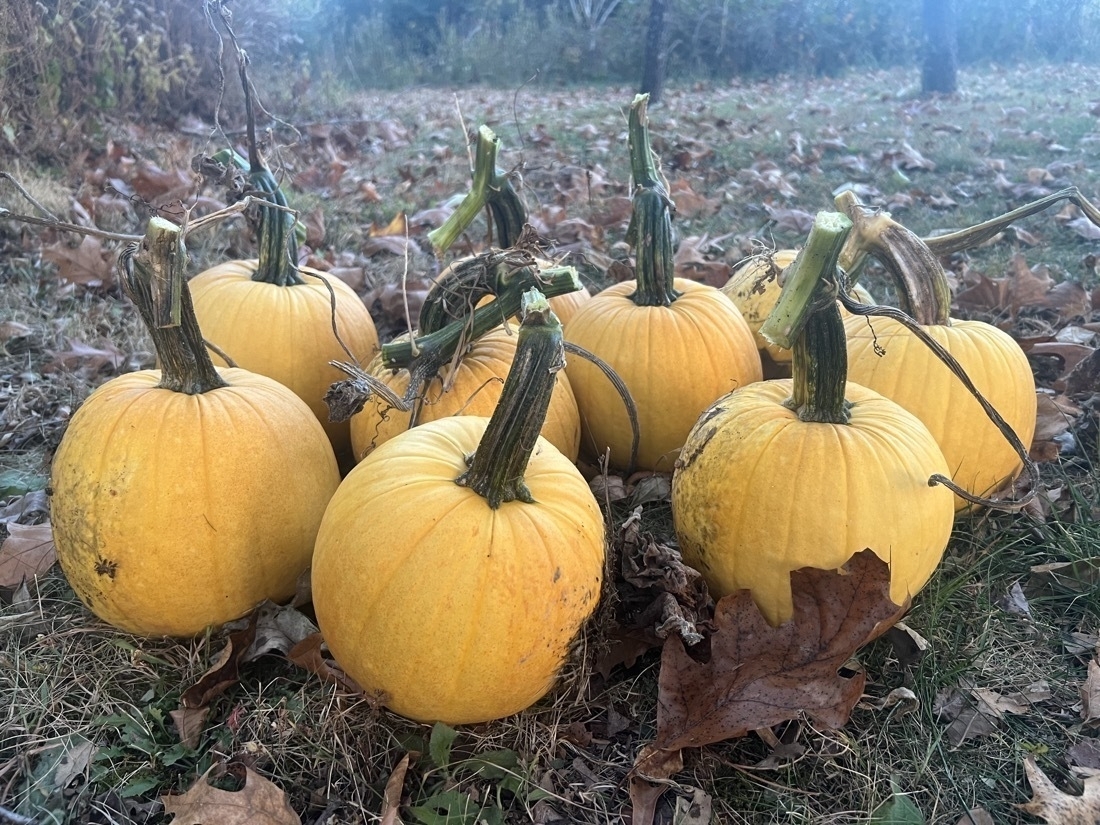
1/2 medium pumkin 1 onion Frozen mixed veggies 1 can chick peas 1 can coconut milk 1 cup macaroni or rice (optional) 1 cup lentils
Salt Garlic Curry Cayenne pepper
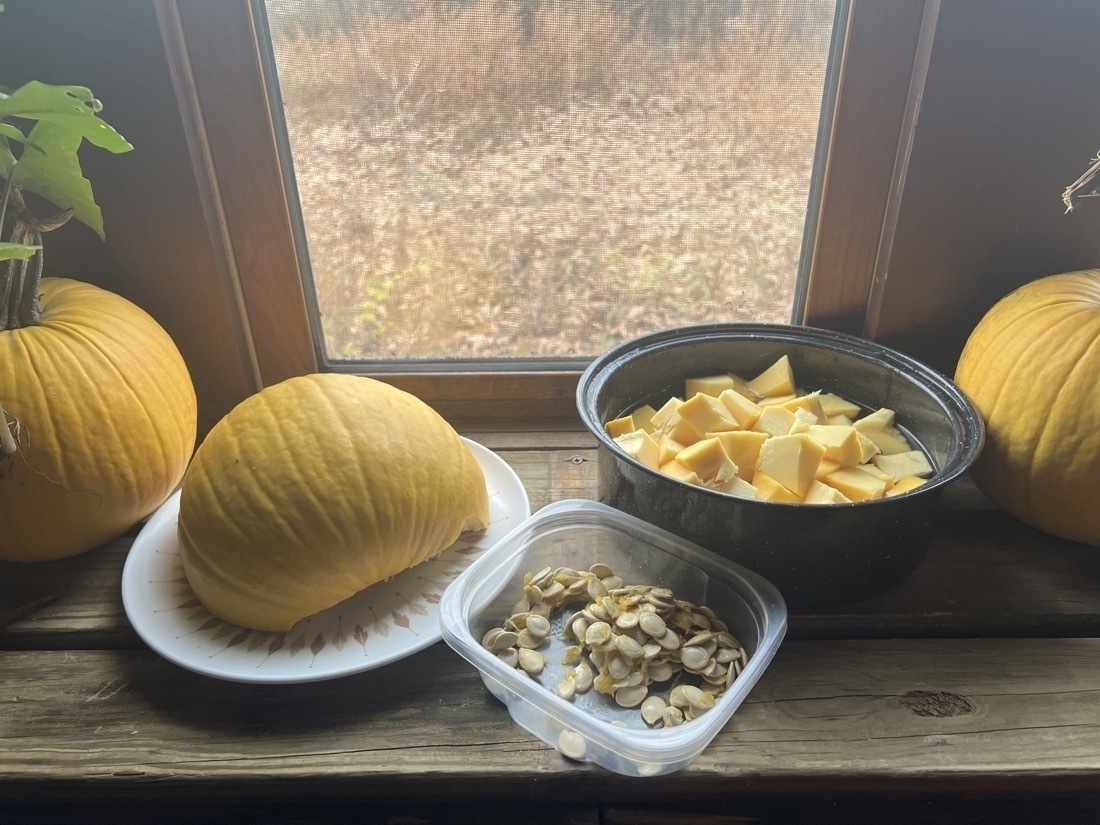
I cut a medium pumpkin in half. 1 half goes in fridge for the next pot of soup in a few days. The other half I cut up into cubes, remove the skin, seeds and stringy inside stuff. Raw pumpkins are pretty hard to cut and remove skin, be careful! I probably need a sharper knife.
Put in a pot with enough water to cover the cubes. Boil for 15ish minutes. Mash it with a potato masher in the pot with the water until it’s just a kind of mash. Set it aside.
Sauté one onion with a little oil and water till soft. Add it to the cooked pumpkin mash. Add spices to taste. I usually do about a tbsp of salt, tbsp of garlic powder (or 3-4 cloves, maybe more), 2 tsp of curry, 1 tsp of cayenne pepper. Alter as needed.
A half bag of frozen mixed vegetables… probably about 4-5 cups. Use whatever veggies you like… I like the standard mixed veggies because they’re usually the least expensive. Bring it to a boil, turn it down a bit and let it simmer for 10 minutes.
Add in a cup of elbow macaroni or cooked rice. And let it simmer for 10 minutes. Add in can of chickpeas (or whatever cooked/can beans you want). Add in can of coconut milk. Let it simmer for 10 minutes. Ready to eat when the macaroni is done.
The soup!
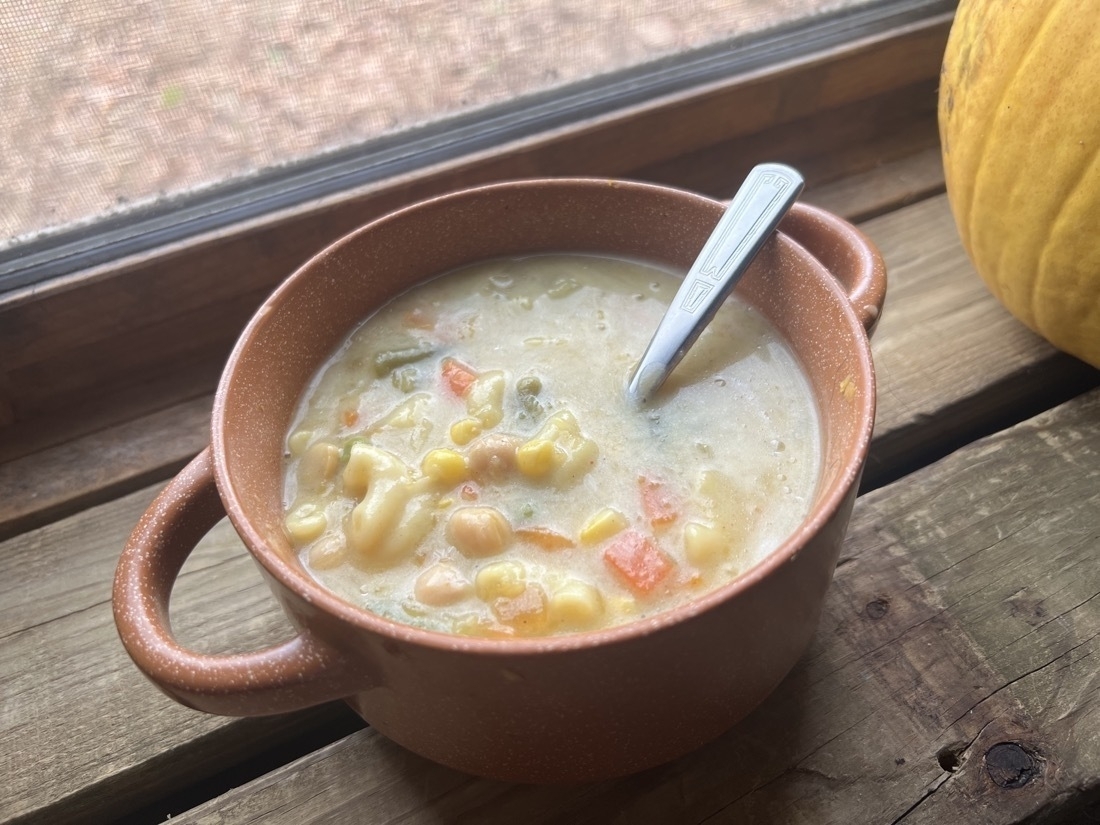
As someone who has enjoyed a daily walk for most of the past 30 years, I deeply enjoyed this.
We are asking what we can get out of a walk, rather than what a walk can get out of us. This might seem like a small distinction, a matter of semantics. But when we begin to think of walking in terms of the latter, we change the way we navigate and experience — literally and figuratively — the world around us.
To understand the difference, we need to ask more about what Mr. Lopez explained is the purpose of all this sensory input. “The purpose of such attentiveness is to gain intimacy, to rid yourself of assumption,” he wrote in his essay “A Literature of Place.”
When I first read that line, I’ll be honest, I didn’t get it. What does intimacy have to do with assumption? And what does walking have to do with intimacy? And what does “assumption” mean?
Opinion | The Transcendent Power of Walking - The New York Times
My aunt often gifts me her extra homemade cookies. If they’re of the really crunchy or sweet variety I crumble one or two into a bowl of Malt-o-Meal (Cream of wheat) instead of adding any sugar. Works in oatmeal too. Makes for a fun, tasty way to reduce food waste!
Learning to walk in the woods
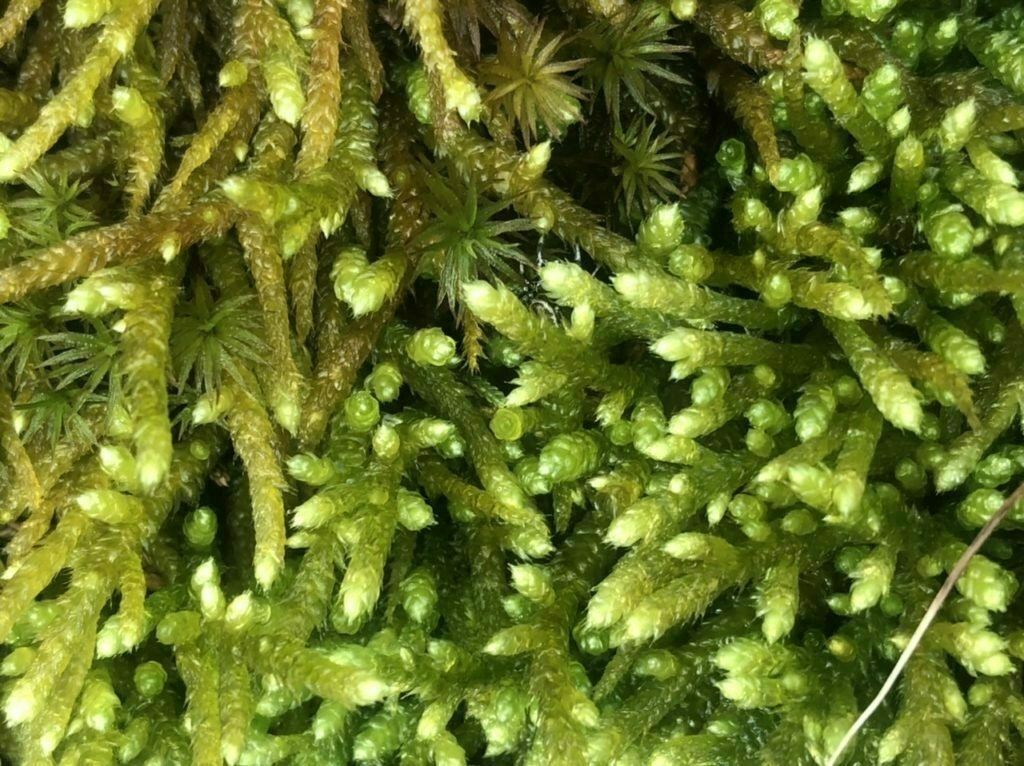 So, file this under “Living here for most of the past 10 years and still get to see something new!” On my trail walk a couple days ago I had my first extended viewing of an owl. I’ve caught sight of them several times while walking but usually it’s when they leave one tree and fly to another and are then out of sight. But on this particular walk I saw one fly and it landed in a tree further down in the direction I was headed. I kept an eye on it and found it in the tree as I got closer. I was able to look for a full minute or so. I could have stayed longer as it didn’t fly away but it was up high enough that I couldn’t see details without binoculars. But still, had a good look. My immediate thoughts were that I need to remember to look up more often rather than my usual focus on the path in front of me.
So, file this under “Living here for most of the past 10 years and still get to see something new!” On my trail walk a couple days ago I had my first extended viewing of an owl. I’ve caught sight of them several times while walking but usually it’s when they leave one tree and fly to another and are then out of sight. But on this particular walk I saw one fly and it landed in a tree further down in the direction I was headed. I kept an eye on it and found it in the tree as I got closer. I was able to look for a full minute or so. I could have stayed longer as it didn’t fly away but it was up high enough that I couldn’t see details without binoculars. But still, had a good look. My immediate thoughts were that I need to remember to look up more often rather than my usual focus on the path in front of me.
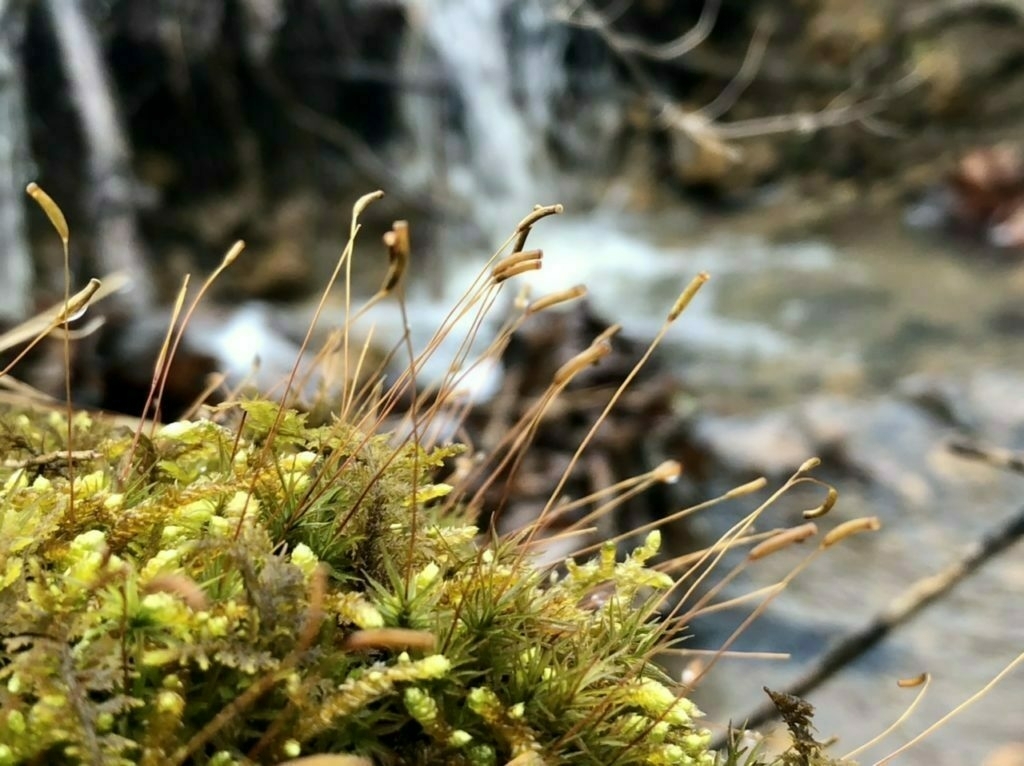
Yesterday while walking after a lot of rain I was stopping often to photograph and video the streams and little water falls. It got me into a more observational mode. While I had to watch the path for slippery spots I was walking more slowly and just generally being in a more observational mode rather than walking for exercise mode. I stopped and just stood still looking off through the woods. With the trees and lower level foliage still bare it’s possible to see a much longer distance. Within just a minute of stopping and looking deeper into the woods, at about the limit of my eyesight, I caught sight of a fox. I should note that I’m not 100% certain given the distance but given the size, shape and movement of the animal I’m fairly certain it was a fox. It was only a glimpse but still, exciting!
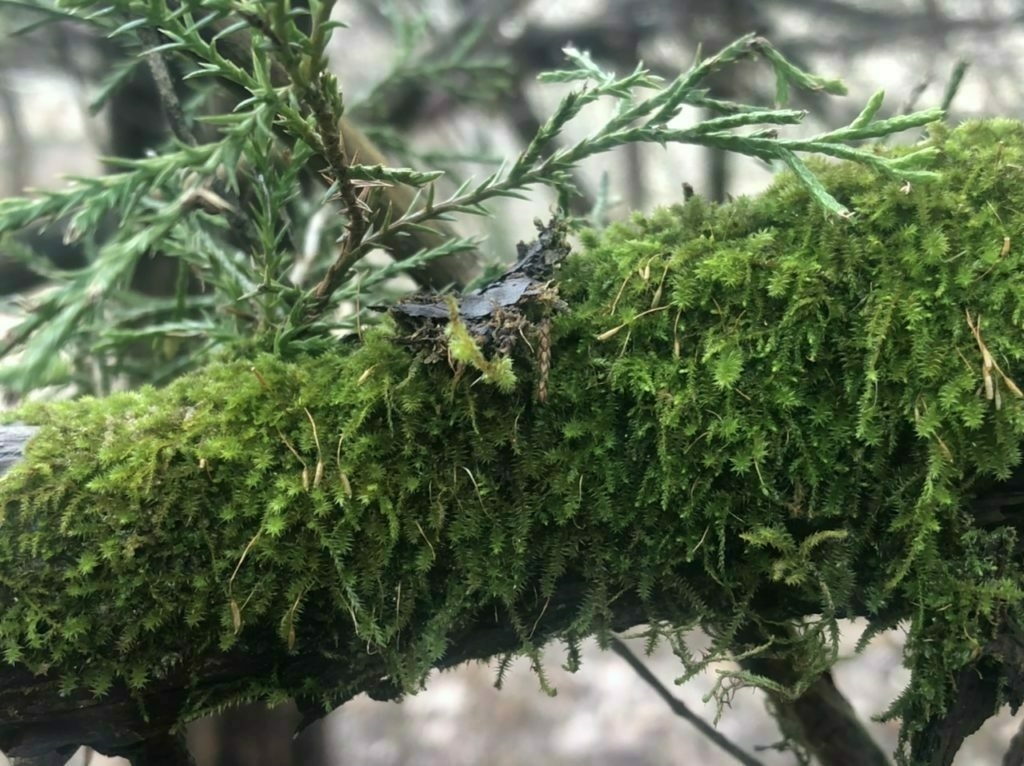
Again, I was reminded what a poor observer I often am. My habit when walking is to be walking. Even if I do rememer to look up I’m usually still moving. So, another lesson learned is that not only do I need to look up more often but that I need to stop and stand still more often. I think that act, of being still for at least a few minutes is what will really allow for much deeper observation of the landscape and what is happening around me. Not only that but were I to carry a small sitting stool or be willing to stop and sit on the ground for say, ten or twenty minutes, that extended stillness would also allow for my becoming less visible to other animals, notably those I rarely see such as fox.
Really it’s an obvious thing I’m stating here but I suspect it’s also something others might forget to do while in the woods. It’s an easy thing to forget to do, especially when provided nice walking paths, to just stop and hold. Also, I’ll note that when I go for walks it is for the purpose of exercise. To walk for observation is a different thing and I’ll need to remember that and find a balance between the two.
Spring is here and all around green buds are popping. In the next few weeks the open understory of the woods will fill with foliage and the long view I’m enjoying now will shrink to a much smaller distance. I plan to practice a more active observation with more frequent stopping and suspect that will be beneficial but it will likely be in the winter months that such a practice will really prove helpful both in terms of wildlife observation as well as developing a better understanding of the topography of the land.
In the woods
I’ve been living in the cabin for most of the past 12 years. The first four were spent mostly outside gardening and clearing the area of tornado-downed trees.The fifth was a lot of time outside at night looking through the telescope and then I left for two years. When I returned in the fall of 2015 I never quite got back into the rhythm of gardening or my time at the telescope. I was still outside a lot but not in the steady, mission-driven way that I had been before. My time outside became more casual and meandering.
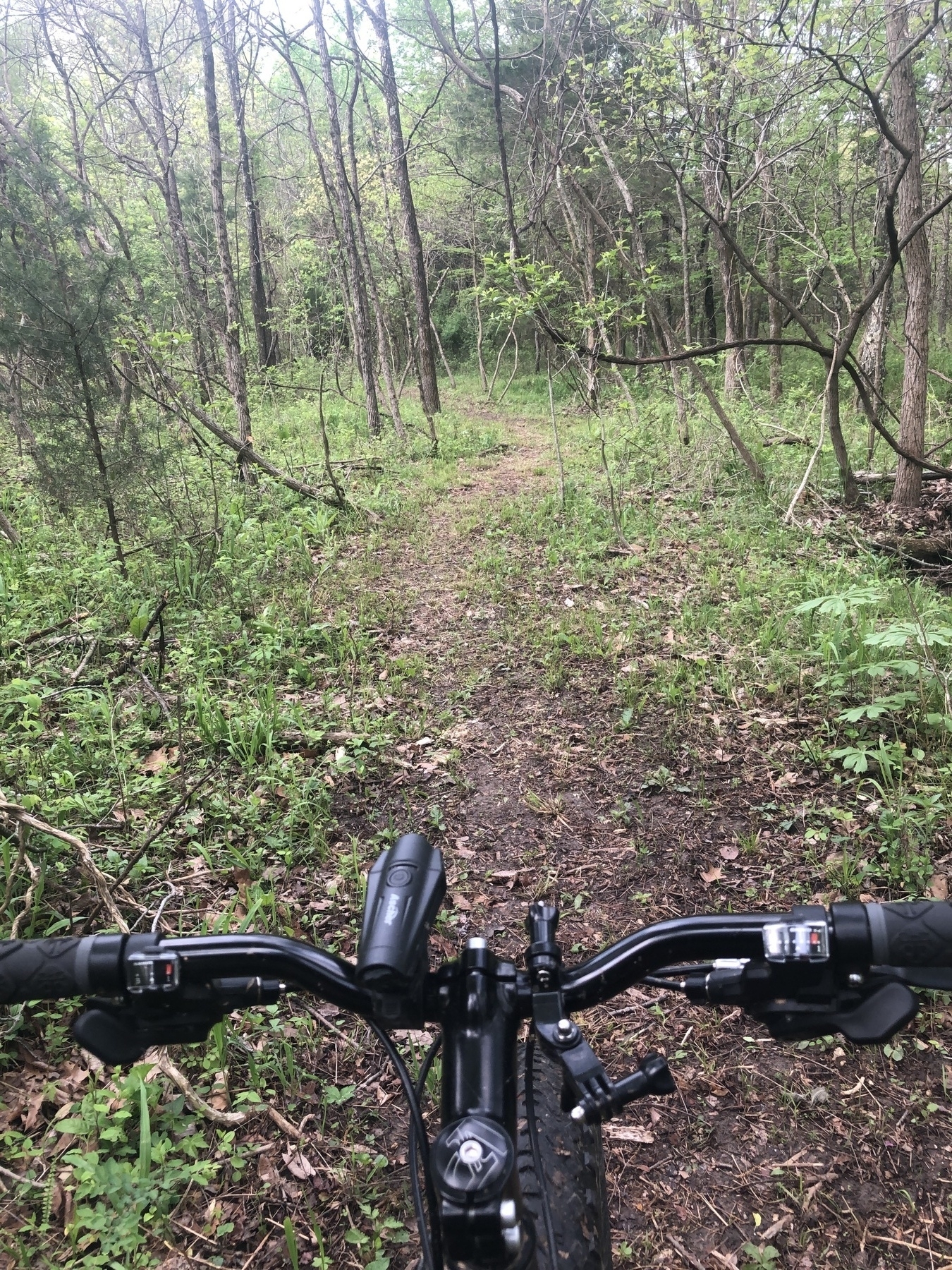
The simple act of just getting out into the quiet woods during the springtime has been a privilege I wish more people had access to especially in these times of the Covid virus. I’m used to having outside time and space so it’s not really new for me but a lot of people are struggling with what to do with themselves.
[caption id="" align=“aligncenter” width=“2780”]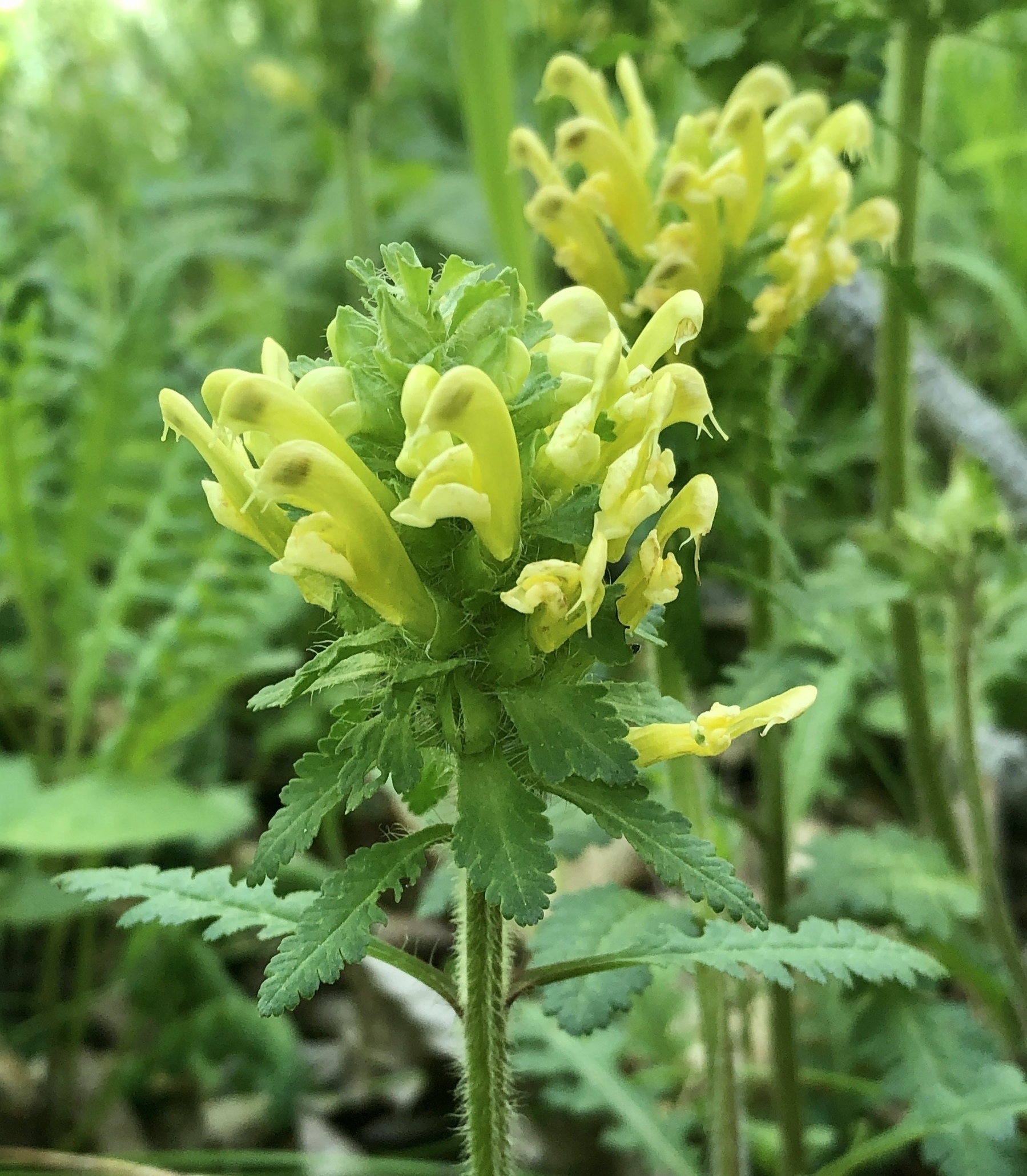 Wood Betony, a favorite spring food source for bumble bees[/caption]
Wood Betony, a favorite spring food source for bumble bees[/caption]
Kitchen Appliances
I’m generally not all that excited by kitchen appliances and this post is no exception. But in the past 3 years I have added three useful appliances to the tiny house “kitchen”.
In the first couple years of living here I had no fridge of any kind. And surprisingly, it is possible to get by without one. It’s easier without meat in the mix. In 2016 I added a small, mini fridge and at some point after that I started keeping a few things in the freezer that is in my sister’s cabin. This past year I decided to get my own fridge/freezer combination. I didn’t want a full size but I wanted something bigger than the normal mini fridge/freezer. After a bit of searching I found a 7.6 cubic foot “retro” Galanz refrigerator. And, for an appliance meant to keep your food cold/frozen, it’s kind of adorable. I’d never heard of the brand but it was the perfect size and I was lucky enough to get it on sale at Home Depot.
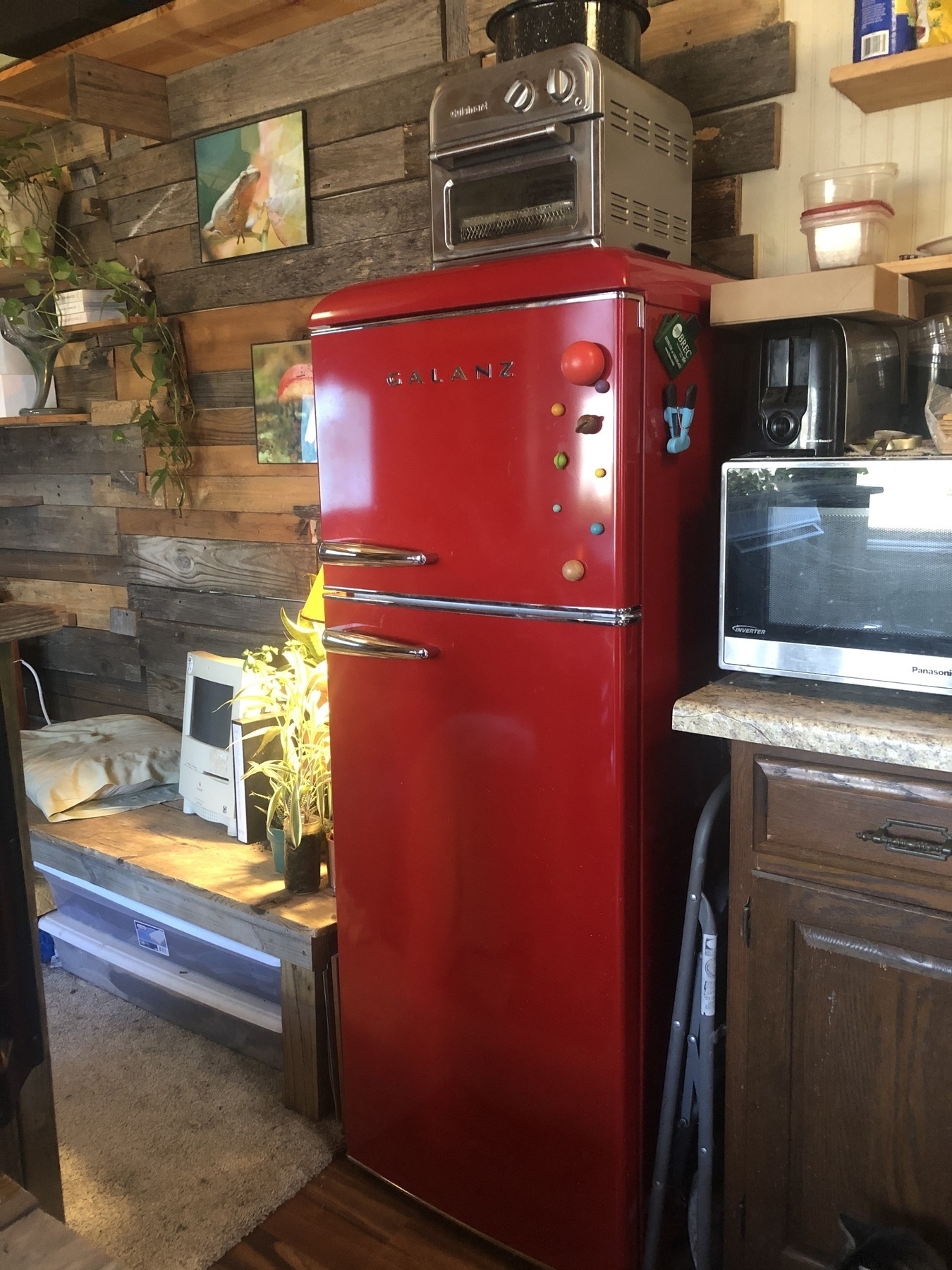
Next, is a small Air Fryer, the Cuisinart AFR-25. Generally my cooking is simple. I use a microwave or an induction (That’s next on the list). At some point in the past I also used a toaster oven with mixed results. After hearing my sister and her family rave about their toaster oven for months I finally bought one and it was a good choice. I use it almost daily. In the summer I use it outside on my deck to keep the cabin cooler. In the fall, winter and spring it fits perfectly on top of the fridge. Thus far I find it most useful for cooking veggie burgers, french fries and little pita pizzas. It’s like having a small oven. The french fries are just long-cut wedges, no oil needed so healthy. The pita pizzas are special treats, simple little pizzas made from pita bread, sauce and cheese. I still use the microwave but this is better for things that benefit from being crispy or for “baking”.
Last would be the induction countertop burner. Around $50 and it’s good. The one critique I have is that parts of the touch control labels wore off pretty quickly with cleaning. There’s enough still there that I can still use it but really, it would seem pretty important that those label indicators not wear off. In any case, it’s a simple, one burner induction stovetop that works very quickly. Great for making soup, pasta, or anything that requires a stove top. Easy to clean. Cooking goes much faster than using other methods and it’s pretty easy to control the temps. I’m sure there are better devices out there but this one has been fine in my experience. Glancing at the Amazon offerings, if I were buying today I’d possibly choose another though I’m not unhappy with this one. The point I’d make is that this type of stovetop is perfect for a tiny house.
192 Square Feet: Part 2
This is part two in a series. The first outlined the first seven months of building and living in a 192 square foot house that would be the first of several tiny structures on a property in Missouri.
My first seven months in the cabin felt a bit like camping and they were fantastic! As I went into my first winter I had the essentials: a warm, dry tiny cabin with electricity and wood heat. I did not yet have running water but I did have a sink that drained. For water I filled three 5 gallon tanks at our well 150 feet from my cabin. Most modern-day citizens of the U.S. wouldn’t want to do that for long as we’ve been raised with indoor plumbing which delivers fresh water out of a faucet. I welcomed the experience because I knew it was temporary and because I knew it was giving me a bit of perspective.
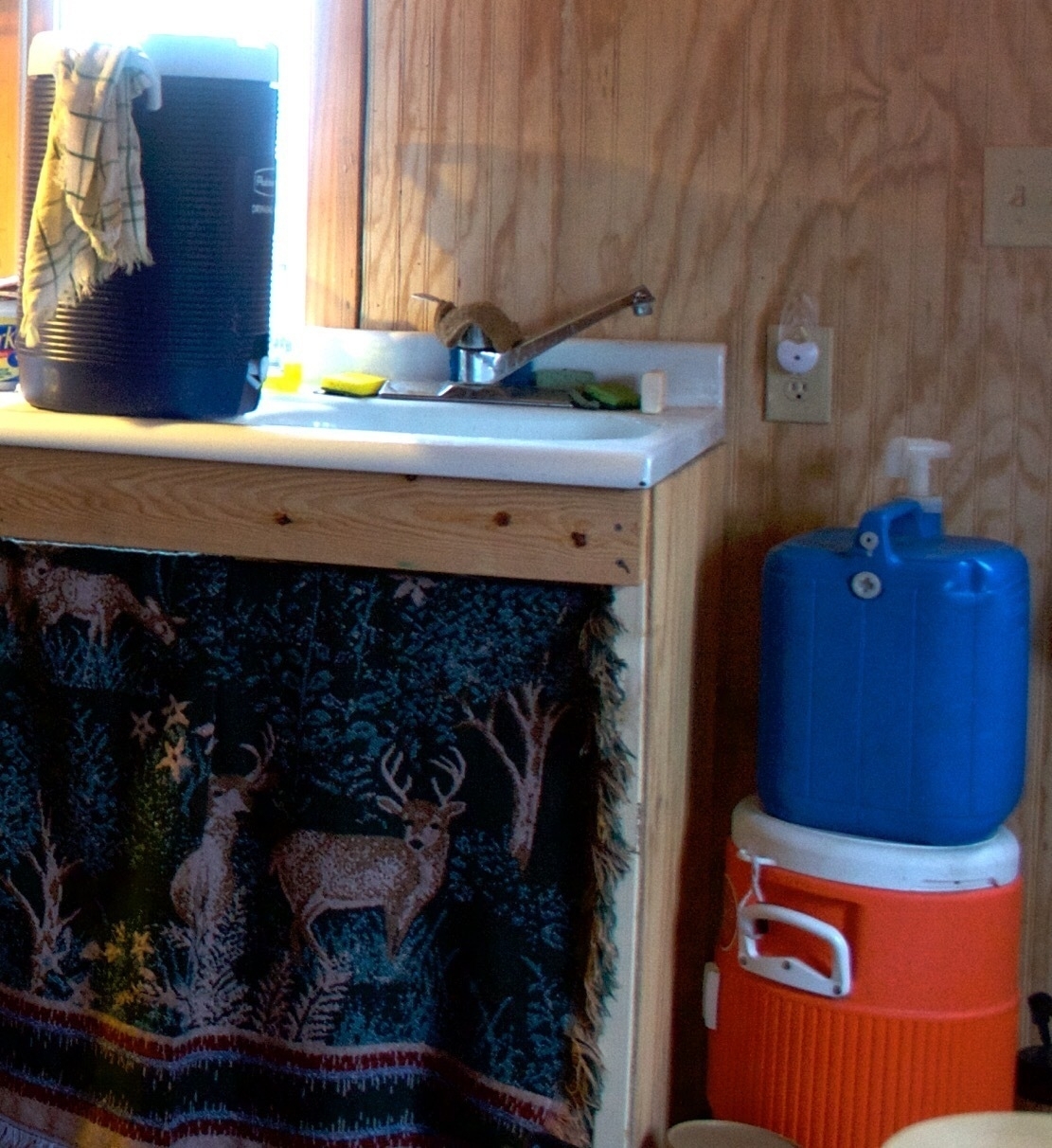 There are still some in the U.S. without indoor plumbing, mostly on Indian reservations and in rural areas. According to this story by the Washington Post the number, as of 2014, was 1.6 million Americans. According to a WHO/UNICEF 2010 report “3.8 billion people, or 57 per cent of the world’s population, get their drinking water from a piped connection that provides running water in their homes or compound.” If I needed to live for a year or so without water coming into my home I might get just a brief taste of what many others live without not by choice but by circumstance. But there’s more. Many of those that do not have a water line into their home also don’t have the convenience of a private, powered well with clean source of water just 150 feet away. I considered myself very fortunate.
There are still some in the U.S. without indoor plumbing, mostly on Indian reservations and in rural areas. According to this story by the Washington Post the number, as of 2014, was 1.6 million Americans. According to a WHO/UNICEF 2010 report “3.8 billion people, or 57 per cent of the world’s population, get their drinking water from a piped connection that provides running water in their homes or compound.” If I needed to live for a year or so without water coming into my home I might get just a brief taste of what many others live without not by choice but by circumstance. But there’s more. Many of those that do not have a water line into their home also don’t have the convenience of a private, powered well with clean source of water just 150 feet away. I considered myself very fortunate.
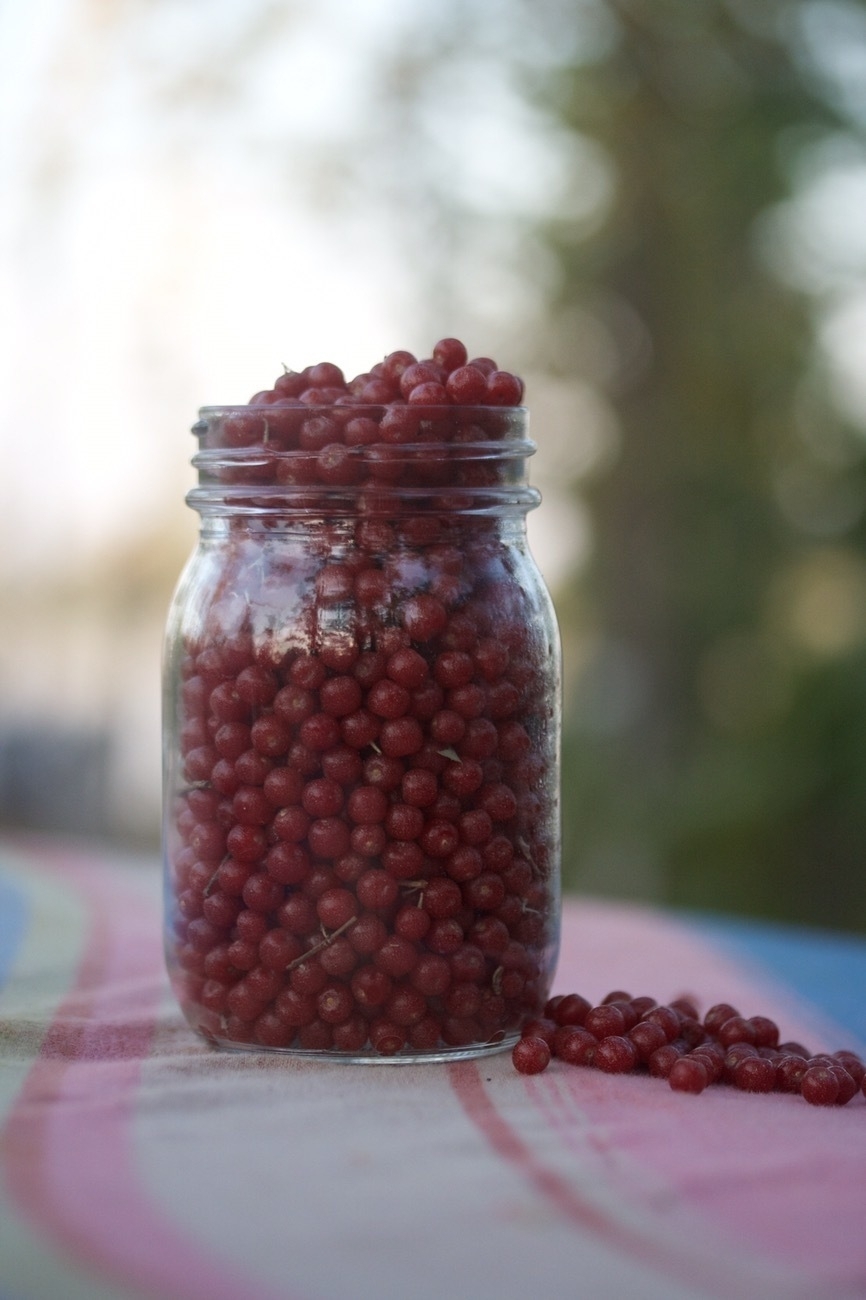 In October and November I put the garden to bed with planted garlic bulbs and lots of mulch all over. Mostly I used cardboard and straw. I mulched over paths as well as beds and areas of grass that were to be expanded garden beds in the spring. An unlooked for but happily discovered fall crop was the Autumn Olive! We have many of them in the area and the bushes not only smell wonderful in the spring but bear huge amounts of tiny red fruit that are not only edible but a real treat once fully ripe!
In October and November I put the garden to bed with planted garlic bulbs and lots of mulch all over. Mostly I used cardboard and straw. I mulched over paths as well as beds and areas of grass that were to be expanded garden beds in the spring. An unlooked for but happily discovered fall crop was the Autumn Olive! We have many of them in the area and the bushes not only smell wonderful in the spring but bear huge amounts of tiny red fruit that are not only edible but a real treat once fully ripe!
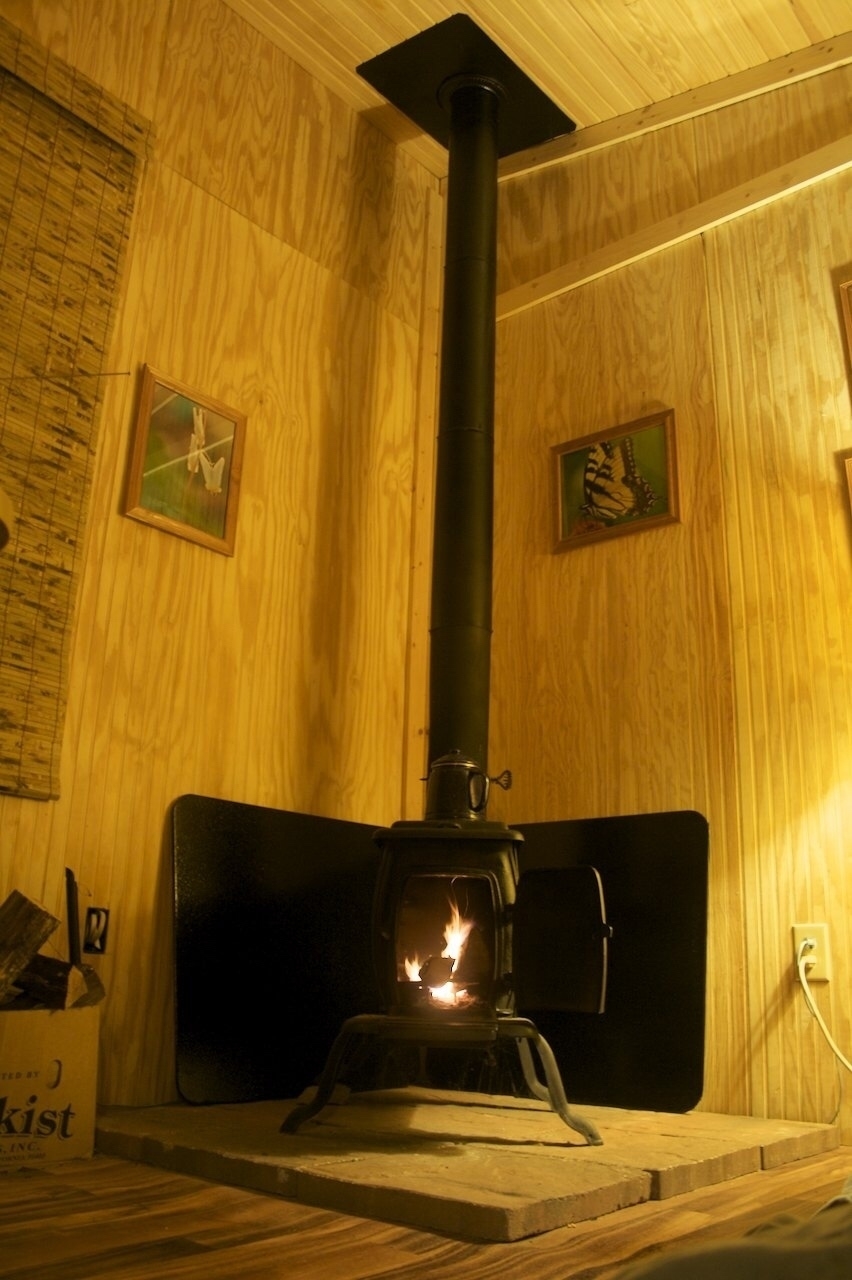 Heating with wood that first winter worked pretty well but in a small space even a smallish woodstove can be difficult for full time heating. What I discovered was that it was very easy to waste wood because it was very easy to heat the cabin too much. With so little thermal mass the cabin would heat quickly and cool quickly. I would put a couple logs in at the start of the day and every couple of hours add another log or two. If I was very careful I could moderate it but the slightest miscalculation meant the cabin was suddenly 85 or 90 at which point I could suffer through it so as to not waste the heat or I could open a window or take a walk, either way I was “wasting” the heat and wood. At bedtime I would put a log or two in and know that I would need to get up in two or three hours to put in more. If it wasn’t too cold I could let the fire go out and start fresh in the morning. I woke up many days to my inside thermometer reading between 45 and 55. Certainly tolerable but not very cozy. This would be an issue I would have to deal with in the future.
Heating with wood that first winter worked pretty well but in a small space even a smallish woodstove can be difficult for full time heating. What I discovered was that it was very easy to waste wood because it was very easy to heat the cabin too much. With so little thermal mass the cabin would heat quickly and cool quickly. I would put a couple logs in at the start of the day and every couple of hours add another log or two. If I was very careful I could moderate it but the slightest miscalculation meant the cabin was suddenly 85 or 90 at which point I could suffer through it so as to not waste the heat or I could open a window or take a walk, either way I was “wasting” the heat and wood. At bedtime I would put a log or two in and know that I would need to get up in two or three hours to put in more. If it wasn’t too cold I could let the fire go out and start fresh in the morning. I woke up many days to my inside thermometer reading between 45 and 55. Certainly tolerable but not very cozy. This would be an issue I would have to deal with in the future.
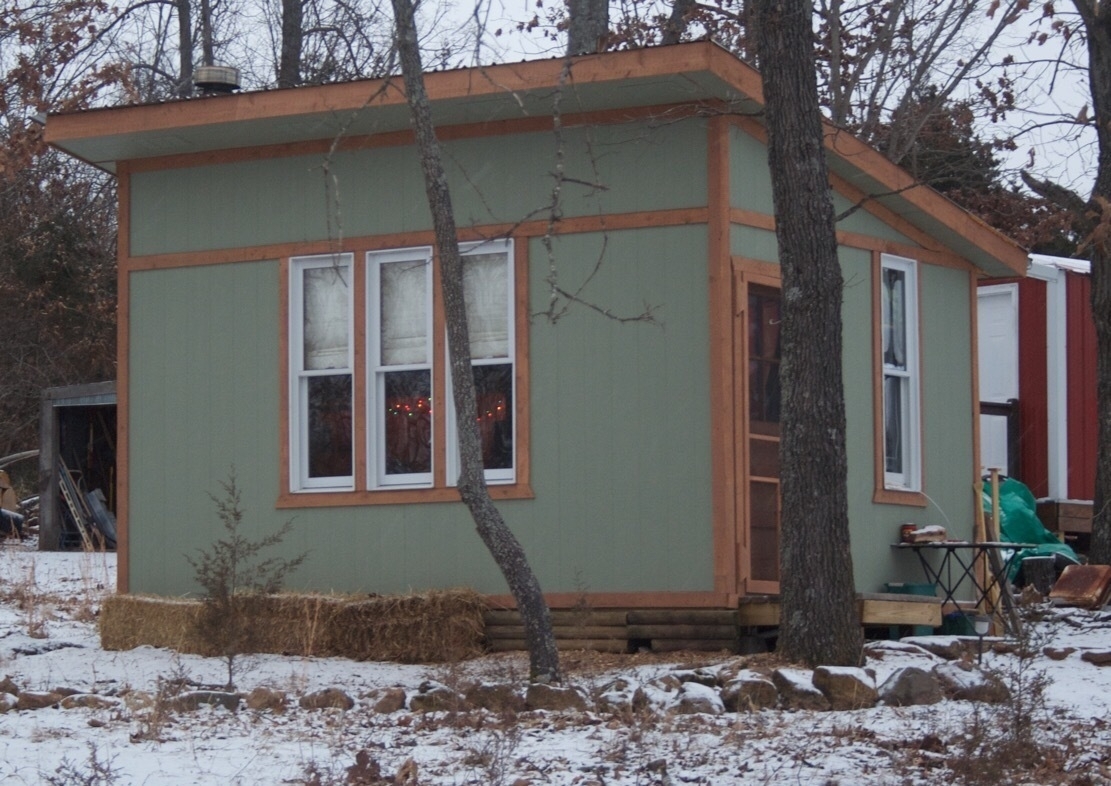 That first winter I also experienced the joy of uninsulated floors! Cold. Too late to do much about it I put down some carpeting and wore slippers. Future plans would include reducing airflow under the cabin as well as increased layers of carpeting. I did come up with a quick fix to slow the airflow on the west side of the cabin which included some salvaged garden timbers already assembled to the right height supplemented by a few bales of hay. The west side was the most vulnerable not only because it had the greatest gap but also because the greatest incoming wind, often over a frozen lake, was from the west. My cabin takes the full force as there aren’t that many trees on that side and those that are there are, of course, without leaves in the winter!
That first winter I also experienced the joy of uninsulated floors! Cold. Too late to do much about it I put down some carpeting and wore slippers. Future plans would include reducing airflow under the cabin as well as increased layers of carpeting. I did come up with a quick fix to slow the airflow on the west side of the cabin which included some salvaged garden timbers already assembled to the right height supplemented by a few bales of hay. The west side was the most vulnerable not only because it had the greatest gap but also because the greatest incoming wind, often over a frozen lake, was from the west. My cabin takes the full force as there aren’t that many trees on that side and those that are there are, of course, without leaves in the winter!
I also learned the importance of monitoring our little well shed. When temperatures dipped to 0 my heating was not nearly enough and the pipes froze. Never again. The key is “heat tape” and a combination of heat lights and/or a heater of some sort. Minimizing the waste of energy also means paying attention to the weather. When the weather warms the heat goes off but of course it is essential to stay on top of things. As soon as temps dip down into the 20s the protective heat has to go right back on.
[caption id=“attachment_877” align=“aligncenter” width=“866”]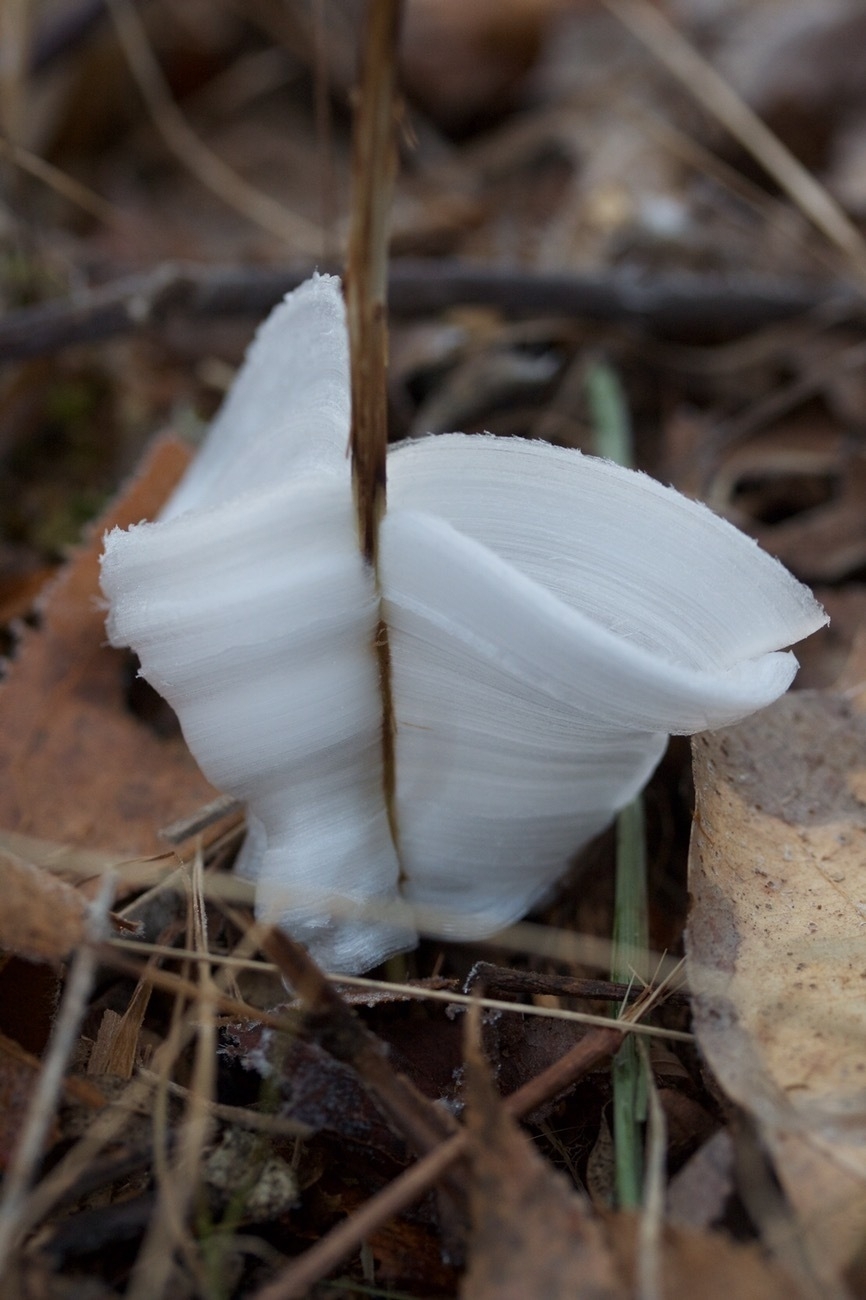 Ice funnels that form when moisture in grass freezes and expands outward.[/caption]
Ice funnels that form when moisture in grass freezes and expands outward.[/caption]
But it wasn’t just cold feet I had to get used to. I’d become comfortable using the outhouse during the warmer months. Using an outhouse at 0° is an altogether different experience! Brrrrrrrr. But as with the carrying of water I viewed it as a learning experience and an expansion of my personal perspective. Funny thing really, I got used to it. Not to say it wasn’t cold each time but it just became a part of life. Yes, it was cold but I survived just fine. Truth is it’s probably pretty funny for anyone within earshot of those first moments of my ass meeting toilet seat as my yelping could probably be heard for several hundred feet. Sorta like someone jumping into cold water. I always have a chuckle at myself in those moments.
One of the benefits of the outhouse, summer or winter, spring or fall, was the sense of connection with the outdoors. In an interesting way using an outhouse or just peeing outside reminds one that in the end we are also animals. Yet another benefit is the usage of “wastes” for the enrichment of soil. Eventually the poop is composted and can be safely used for fruit trees. The urine is great for adding nitrogen to compost. What goes in comes out and it’s best to put it to good use.
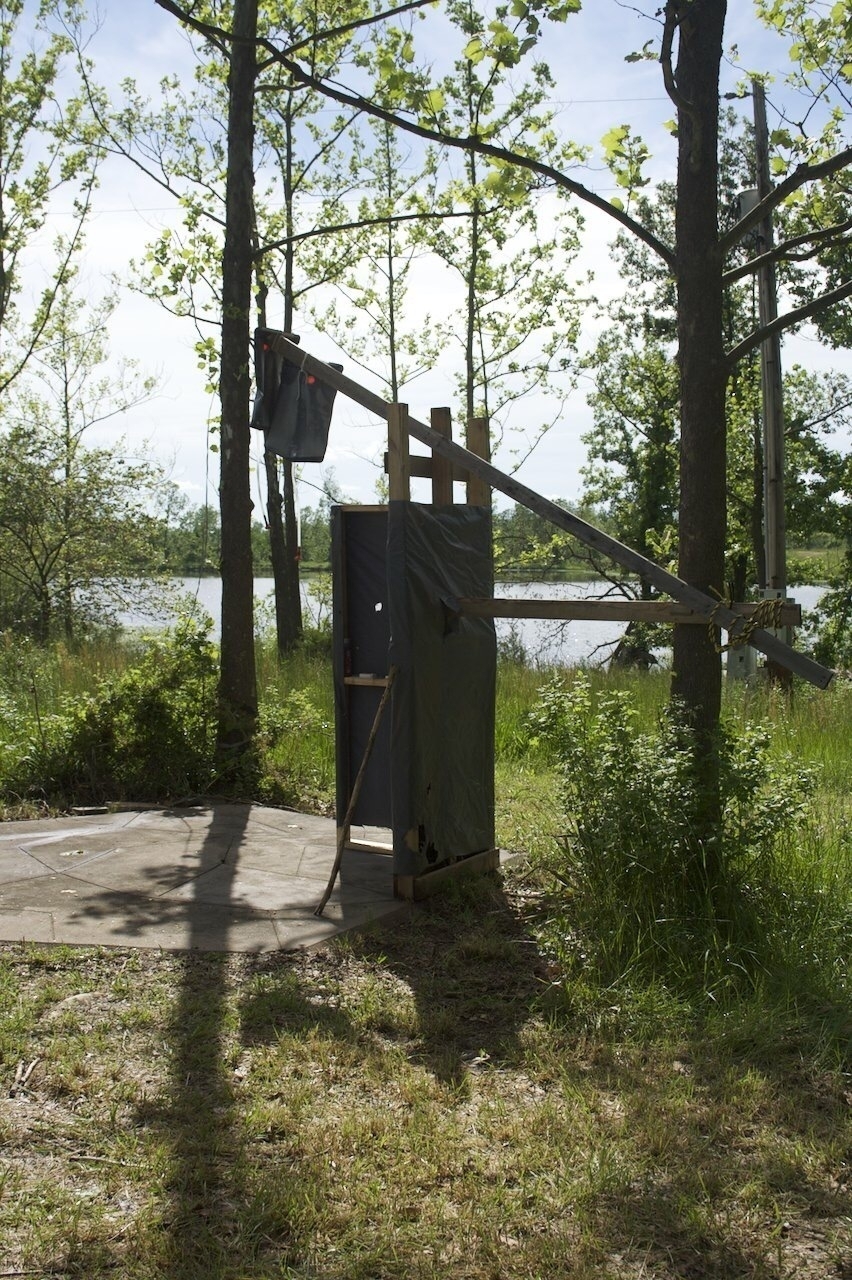 You may remember that I also did not have an inside shower. I used the outside solar shower until it got cold. I used the shower in Kerry and Greg’s cabin until they turned their water off for the winter. That was probably late November. Now, this is where some of you get grossed out and where I get to share my thoughts on modern bathing habits. You see, for me, this wasn’t a huge problem. And yes, I hear you snicker, but what about the people around me? Might my stink not be a problem for them? Oh, I see a rabbit hole, let’s jump in!
You may remember that I also did not have an inside shower. I used the outside solar shower until it got cold. I used the shower in Kerry and Greg’s cabin until they turned their water off for the winter. That was probably late November. Now, this is where some of you get grossed out and where I get to share my thoughts on modern bathing habits. You see, for me, this wasn’t a huge problem. And yes, I hear you snicker, but what about the people around me? Might my stink not be a problem for them? Oh, I see a rabbit hole, let’s jump in!
Modern humans of the “developed” world are far too concerned with being “clean”. We’ve got antibacterial soaps and wipes. Women are convinced that they must shave or otherwise remove much of their body hair. So as to limit our body odor we use deodorants and anti-perspirants. Some people shower daily. I’ve known some that shower twice a day regardless of whether they break a sweat during the day. What are we so afraid of? My disdain for too much cleanliness is not just opinion. Oh no, I’ve got science too. Well, to be specific I have preliminary science because as is often the case, science is tentative.
Ever heard of the “hygiene hypothesis”? In short the idea is that we have become too clean. In our war against “germs” we have greatly reduced the helpful bacteria on which we depend. The contention is that we have become more susceptible to asthma and autoimmune problems because we have reduced our body’s exposure to “germs” which it uses to program the immune system. This is especially important for children who’s bodies are most in need of the “programming”. Not only that but our gut and skin biomes have been greatly reduced. Again, these are necessary bacteria (and fungi and archaea) with which we have a symbiotic relationship. We_ need them to survive._ We call this aggregate of microorganisms the human microbiota. Get used to it, your “body” is actually a community with non-human cells outnumbering human cells by 3 to 1. Fantastic!
For a more academic read there is this. There’s a great deal to be said on the subject and I don’t want to go too far down this rabbit hole. For now I’ll conclude by suggesting that I am clean enough. I found ways that first winter to clean-up without a shower. And for the record, while I wouldn’t want to use an anti-perspirant I am happy to use deodorants. Interestingly I’ve been told by family and a few close friends that I have a unique Denny smell. They contend that it’s not a bad body odor but just a unique smell. I’m guessing that for most of human history each person had such a personal odor. It’s only in recent times that we’ve sought to so completely remove it’s traces.
Okay, now that we’ve covered that I’ll bring the tale of the first year to a close. I not only survived the winter but I thoroughly enjoyed it, frozen feet, icey butt cheeks and all. Spring was around the corner and I would soon be very busy with the garden. Tomato and other warm season crops were seed planted in trays and cool season crops such as peas and lettuce were direct seeded into the garden. The plan for the spring included a chicken coop and attached greenhouse as well as a new cabin for Kerry and Greg’s kids. Oh, and honey bees! Lots to do. More to come!
192 Square Feet
A note about writing this. My initial intent was to post a bit about what it’s like to live in a small space but as I worked on that post it occurred to me that for my own purposes I’d like to have a more complete story of this process. I thought it would be interesting enough to offer more details is a series of posts so, I present you with part 1.
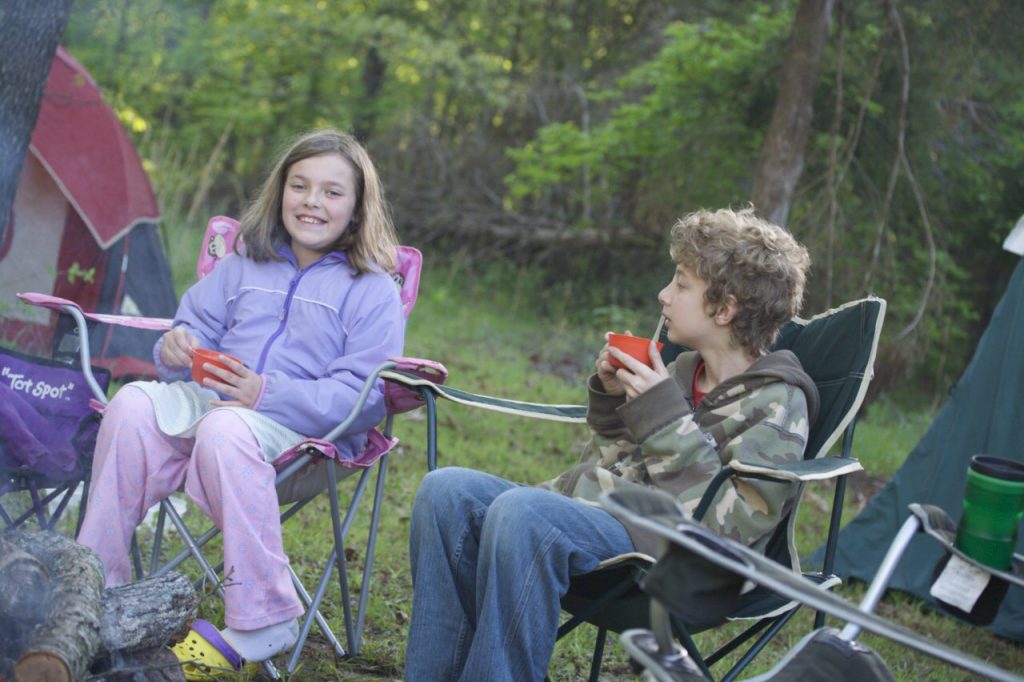 Camping during construction. My niece and nephew.
Camping during construction. My niece and nephew.
In the spring of 2008 I made a decision to begin a new living arrangement. With the economy tanking and my life in a period of transition I put thoughts of moving to Maine or Oregon on hold and decided to stay closer to my family in Missouri. With the help of my brother-in-law Greg (who is the real builder) we began a project the family had long talked about. A little village of sorts on our share of land that had been left to us by our grandparents.
Now, before I get into the story I should offer up that I am not a builder. My first recollection of building things was watching my parents help my aunt and uncle as they built a barn and house. But the adults worked, the kids played. I didn’t learn much. A few years later I remember helping my dad build our deck. I should add that my dad is also not a builder. My recollection of the process was one of frustration. My dad’s frustration as well as my own. In the end we had a very nice deck but I don’t recall it being an enjoyable or rewarding process. It may well be that I was just a bratty kid that didn’t want to spend his precious weekend helping build a deck but other memories reinforce the idea that my dad was often frustrated when trying to take on such projects. He wasn’t confident and didn’t enjoy it or at least that’s my recollection. I say this to help explain my own adult tendencies to avoid construction projects and my own lack of confidence in such endeavors. But in the spring of 2008 I did want a cabin and I wasn’t prepared to pay for one. Given that we had larger plans for multiple tiny buildings the choice to learn and work was obvious.
I knew some of the basics. Previous experience (as an adult) included replacing a part of the roof at deCleyre as well as helping a friend with a roofing job. Also, I’d helped Greg on a few renovations of their home. He had the experience and had a pretty good idea of what he was doing but I’m observant and had watched him closely. During their home renovations I’d used a nail gun, hammer, circular saw, sawzaw, jigsaw and drill. I had a pretty good idea of what it meant to build a standard 2x4 wall. I ran the electrical wiring and helped put up the drywall. I knew the building of my simple one room cabin was really just a process of building a wooden platform, four 2x4 walls, and, finally, a roof. Then all the details of adding in windows, doors, outlets, insulation, inside walls, etc. Not only did we build my cabin but we renovated a shed and built 4 other structures. At this point I don’t doubt that I could build a cabin on my own should I need or want to. Thanks Greg!
Our first building on the property was an outhouse because we knew we’d need some sort of facilities. We had that built in a weekend. It was a simple structure designed so that I could easily empty a large bucket when full. I set-up an out of the way area for a humanure compost pile which can be safely used after a couple of years .
The following weekend we set-up tents and an outdoor kitchen in an old shed. Then we spent a month (weekends only) building my 12x16 cabin. The plan for the cabin was simple. I needed something big enough to live in. I don’t own much so basically a single, multipurpose room for sleeping, working, hanging out, food storage/prep and eating. No bathroom as I planned to use the outhouse and bathing would be done outside with a solar shower and then I’d have figure something out for the winter.
Looking back on it now there are two things I would have done differently. I would have insulated my floor and I would have built it bigger to accommodate a small bathroom. If I’d gone just 4 feet more, 12 X 20 instead of 12 X 16 I’d have more room for the bathroom. But that’s it. Generally I don’t mind the lack of a bathroom but if I stay put for the long haul I’m likely to want the convenience of one. As I expected I have found that living in a small space has worked very well for me but more about that later.
We arrived to begin work on Friday night. We set-up camp and cleaned the cabin site a bit. Saturday morning we finished clearing the site of debris and started the floor platform made of treated 2x12, 2x8, and plywood. That was finished by Saturday evening. My back was already hurting.
Sunday morning started early with building the 2x4 walls. By Sunday afternoon we had the outer wall panels up. By Sunday evening we had the roof on and had the holes cut for the windows. We had a blast and had squeezed in more than 28 hours of work in 2 days and an evening. We were exhausted. We left Sunday evening after dark and I have no idea how we got home. Somehow Greg managed to stay awake while he was driving though I have no idea how.
The second weekend was adding in windows, door and electrical. I actually moved in at the end of the weekend because while it was far from finished it was a pretty weather proof shelter. It was like being in a tent except the eaves were not yet enclosed which meant flying critters got in. I woke up to a bird in the cabin one morning. There were a few flies, june bugs and other assorted winged creatures including a couple of birds that popped in one morning. There were mice. While I had my cabin ready for electric we did not yet have service hooked up so I would be using lanterns for a couple weeks. But it was home and I was happy to be in it. If that meant sharing it with a few critters well then, so be it. I was eager to get started on the garden. I had several trays of seedlings that we’re going to need a home and my garden consisted of a small field grasses and flowers.
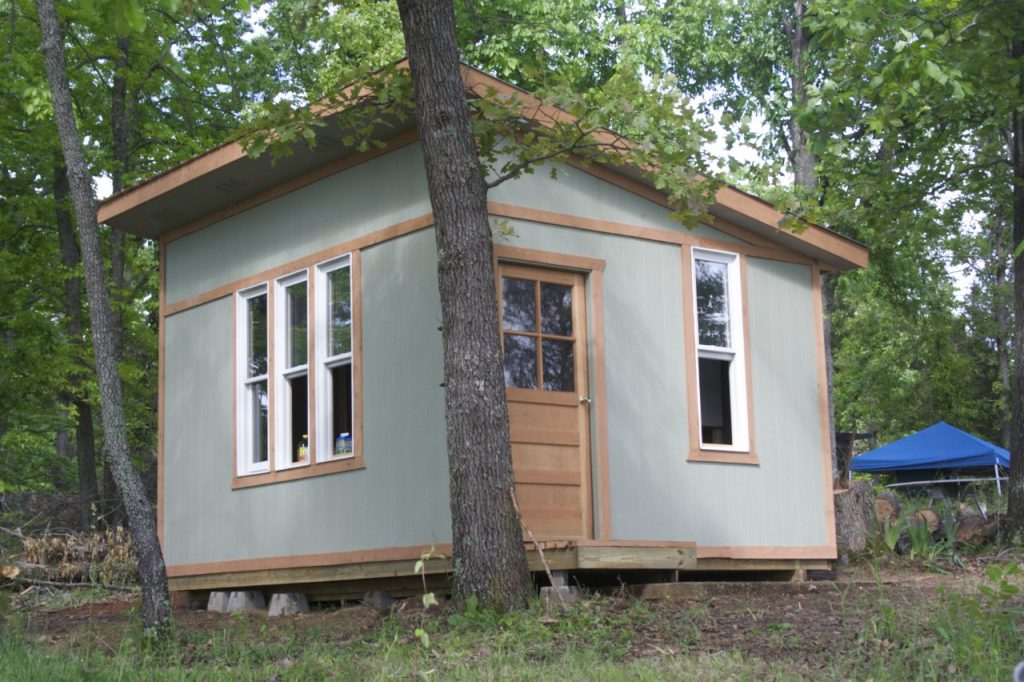 Nearly finished on the outside!
Nearly finished on the outside!
The next couple of weeks were spent alternating between gardening and building. On weekends Kerry and Greg would come with the kids and we would build while the kids played. They’d not had a whole lot of time at the lake up to this point and were just getting to the age where they could explore a wee bit. Mornings were spent around the campfire then we’d break off to work on the cabin and the kids would fish or swim with Kerry. By the last weekend of May the cabin was painted and mostly enclosed. By the end of June we’d gotten the cabin fully enclosed, the cabin painted, a ceiling fan installed and the wood slat ceiling was in place.
My weekdays were spent gardening and cleaning up the various bits of debris left from a tornado that passed through 2 years prior. I refused to use any gas tools with the exception of a chainsaw. All the darkening was accomplished with a mix of labor and time. I cleared out the garden area with a sickle and then an old fashioned non-gas reel mower. My family thought I was nuts but I put it down to idealism. It took longer to do it the way I did but it was great exercise and frankly, I enjoyed it immensely. The spring, summer and fall of 2008 might be best described as pure joy and exhaustion. In my 39 years I had never worked this hard. I’d always worked, always kept busy but never had I physically worked from sun-up to sun-down. I fell into bed each night aching and exhausted. I was gaining a whole new appreciation for what life would be like without modern conveniences, without oil.
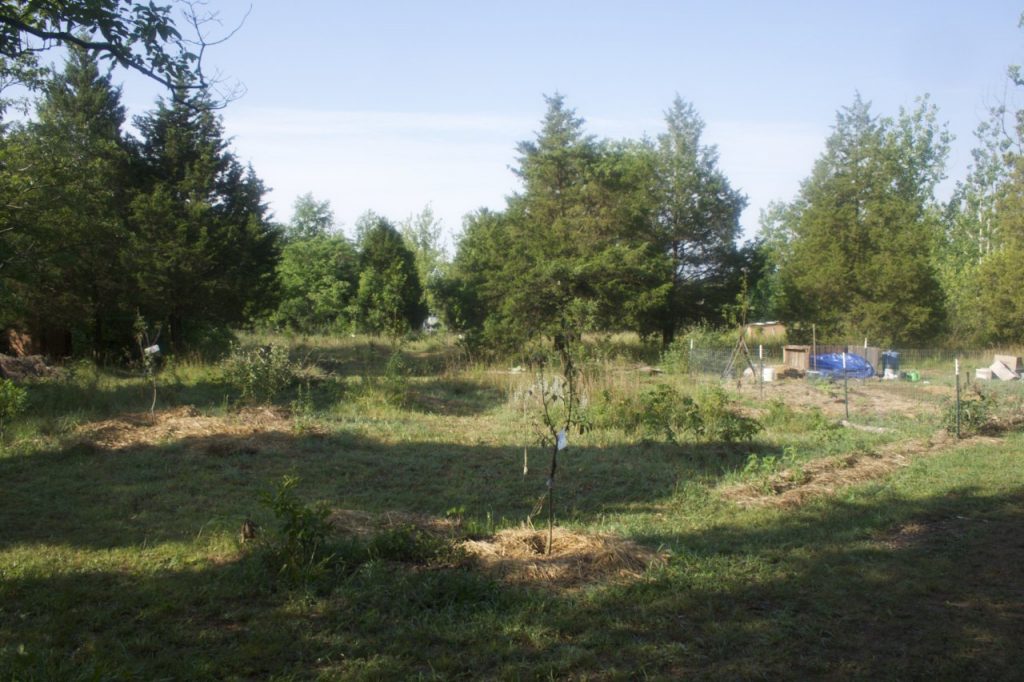 Forest garden and orchard. Fencing up, beds in, compost pile underway.
Forest garden and orchard. Fencing up, beds in, compost pile underway.
I had a small garden going by the middle of June. I considered it garden phase 1. In a month I had put up fencing, put in double-dug beds and mulched it all with cardboard and straw. Greg had begun picking up fruit trees on sale at the big box stores towards the end of June and they needed to get planted. I sickled and reel mowed pathways into a couple of areas I had planned for fruit trees. July and August will remain a blur of planting fruit trees, hauling lake water in 5 gallon buckets and weeding the garden. I’m happy to say that I didn’t loose a single tree which is saying something because these were all pretty neglected when they got here as they were sale trees that hadn’t sold at Lowes and other places. By the end of July we had a mix of peach, plum, apple, and a single pear, about 15 all together.
In mid summer Greg and Kerry found a good deal on a shed that would become the base of their cabin. We had the shed hauled from 60 miles away and added it to our budding mini-village. It’s a work in progress that continues today with plans to close in the current porch and add a new porch of recently salvaged decking.
At some point in mid summer I also began clearing out the lake front which had a downed tree covered in tall grass and flowers. There was another tornado downed tree behind my cabin and damaged trees all around the area. I gradually removed branches and cut the fallen trees down to firewood sized logs and sickled away the tall grass. Yes, this was the summer I finally became familiar with the chain saw. Previous to this I’d only ever used a chainsaw a handful of times. I was never comfortable doing it in part because I did it so infrequently. By the fall of 2008 I’d racked up many back-breaking hours with my new friend, an old red Homelight which I’m still using today. It had been my dad’s but he loaned it to me and then gifted it when he saw that I was actually using it far more than he had occasion to. It’s not the biggest chainsaw but big enough to handle small to medium tree trunks. By early October I had one or two ranks of wood chopped and ready for winter and the lake front was cleared enough that I now had a mostly unobstructed view of the lake.
Greg had come down several more times through the summer and in early August the walls had all been insulated and finished with wood paneling. As the leaves began to turn to their fall colors we put a bed and storage/guest sleeping loft followed by the wood stove. One of the last projects of the year was putting in some salvaged cabinets and a closet with some shelves and a countertop. My “kitchen”, improvised for most of the summer, started to look like a real kitchen. For much of the summer I’d used an outdoor sink set-up that functioned pretty well. But as the cold weather would be coming soon I decided it was time to move the dishwashing inside so we put in a sink though no running water. I used 3 five gallon water tanks hauled from our well house, usually just one a day. I had always been conscientious about my water use but when I was hauling all of my water by hand I can tell you I became even more careful. This was especially true in the winter when I was hauling the water 150 feet through the snow.
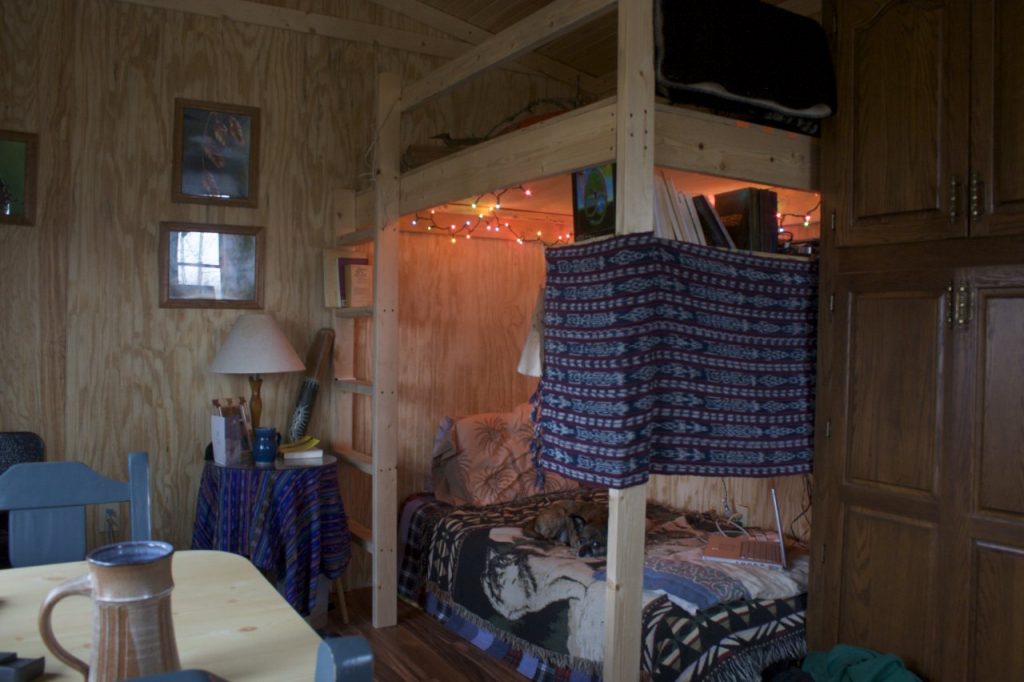 My bed, storage and guest loft above
My bed, storage and guest loft above
The summer of 2008 was busy but we were just getting started. Part 2
Big on Small
I’m big on small and have been for much of my adult life. Not just small but tiny if at all possible. What might it mean to be small?
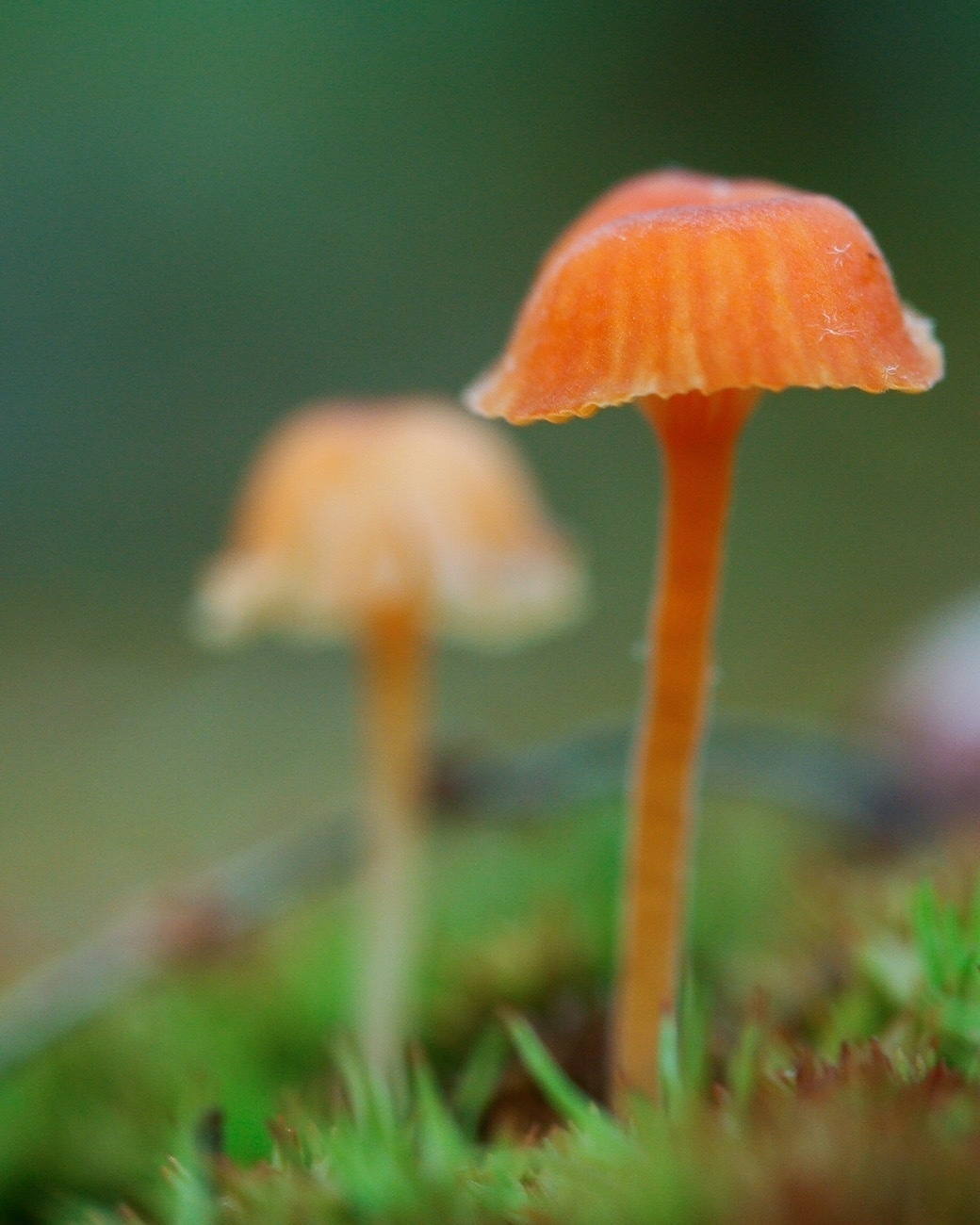 I’d suggest that we just start by acknowledging our own smallness. We spend much of our lives in a relentless effort to find or create our identity which is a part of proving our worth to the world around us. It might be that we do this with good deeds or, as often seems to be the case, with accumulation of one sort or another. It’s this latter bit that leads so many to a lifetime of bigger houses, faster cars, prettier clothing.
I’d suggest that we just start by acknowledging our own smallness. We spend much of our lives in a relentless effort to find or create our identity which is a part of proving our worth to the world around us. It might be that we do this with good deeds or, as often seems to be the case, with accumulation of one sort or another. It’s this latter bit that leads so many to a lifetime of bigger houses, faster cars, prettier clothing.
[caption id=“attachment_812” align=“aligncenter” width=“1300”]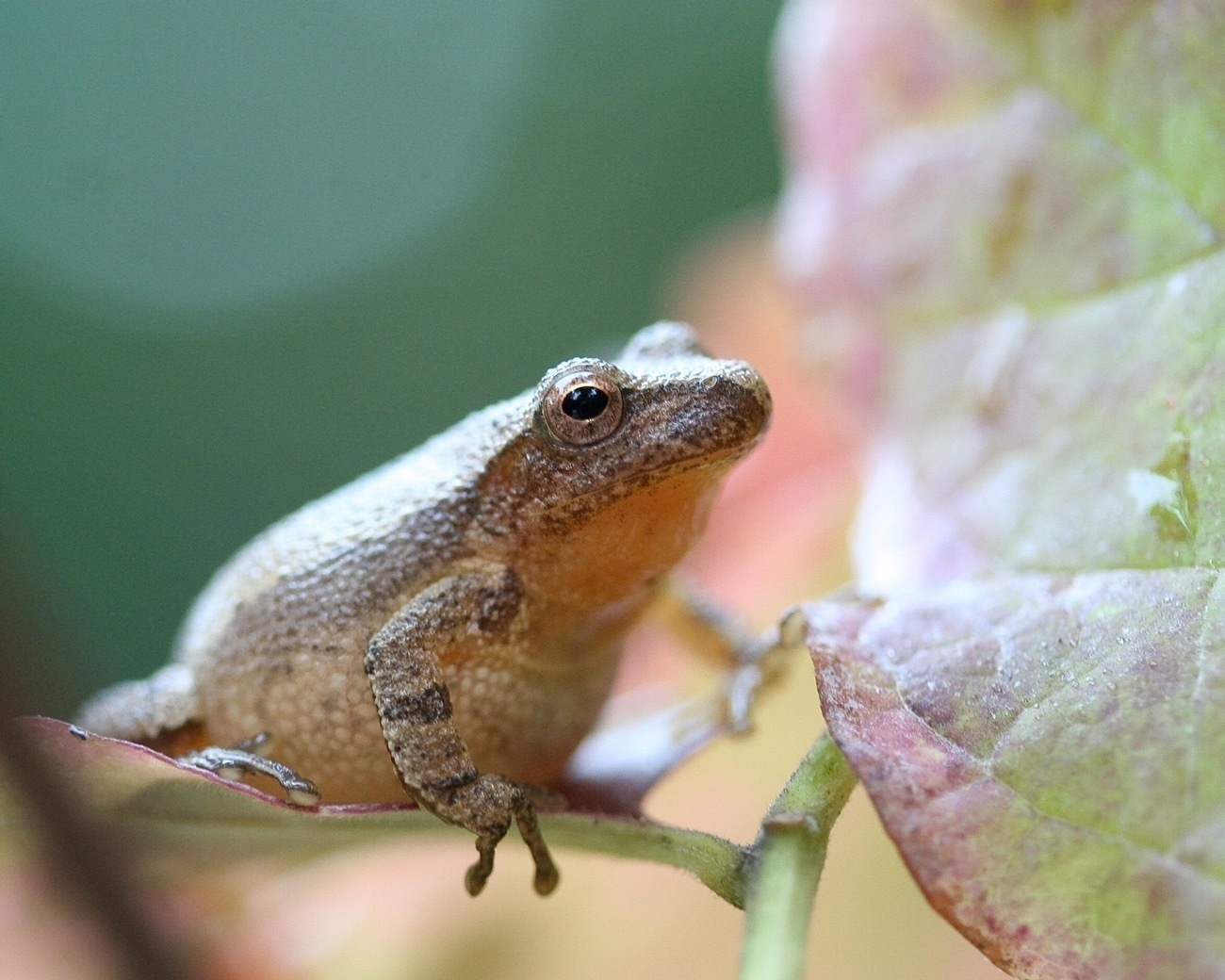 Spring Peeper[/caption]
Spring Peeper[/caption]
But really, we are, each of us just a tiny being sharing a tiny planet with 7 billion other tiny beings such as ourselves. And, of course, our tiny planet is just one of many billions in our galaxy which is itself just one of many billions in the known universe. To say that we are small is an understatement. And yet, our scale, both in physical size as well as in time, is what we experience day to day. It’s what we know and what we function in.
[caption id=“attachment_813” align=“aligncenter” width=“1300”] Earthrise[/caption]
Earthrise[/caption]
Our lives are small in so many ways. In the span of humanity we are but a tiny blip. Humanity itself is just a moment in the larger span of time. It’s easy to feel insignificant and in a strange way we many of us spend much of our lives trying to prove ourselves otherwise. Steve Jobs referred to it as “putting a dent in the universe.” The striving to leave a mark, to leave our mark. Sadly, in our striving to leave a mark, the collective mark we may leave is more a scar on the tiny planet we inhabit. Our mark might well be not just our own extinction but it is, as I write these words, the extinction of many other species.
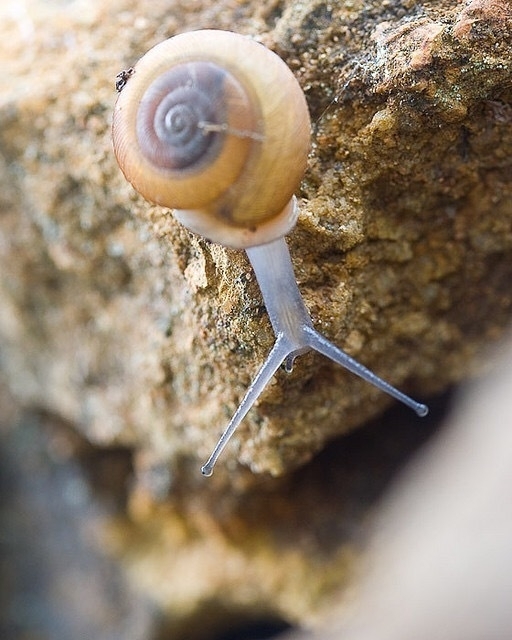 Another example of small is small as in intimate, which is to say, being aware of the simple things up close. When I take a walk in the woods I walk slowly. I’m happy to take a long hike for exercise but to truly explore I only need to venture out a few hundred feet outside my door. More often than not we miss the little detail going on all around us. It might be a cluster of tiny fungi growing in a carpet of moss. Or a snail moving across a rock. Those tiny things are easy to miss, especially for adults. We get busy with making life complicated and we tower so far above our toes that we rarely take the time or make the effort to see the world around us from a different perspective. Some of the most interesting stuff of life happens on this small scale.
Another example of small is small as in intimate, which is to say, being aware of the simple things up close. When I take a walk in the woods I walk slowly. I’m happy to take a long hike for exercise but to truly explore I only need to venture out a few hundred feet outside my door. More often than not we miss the little detail going on all around us. It might be a cluster of tiny fungi growing in a carpet of moss. Or a snail moving across a rock. Those tiny things are easy to miss, especially for adults. We get busy with making life complicated and we tower so far above our toes that we rarely take the time or make the effort to see the world around us from a different perspective. Some of the most interesting stuff of life happens on this small scale.
 What begins as awareness can grow into appreciation and respect. It’s been my experience and observation that in the hustle and bustle of “modern” life we have disconnected from many important processes that are obvious if we’re paying attention but easily invisible if we’re not. Everything from soil building via decay to the hatching of turtle eggs to the transformation of a Monarch from larvae to butterfly. Life and death is happening all around us.
What begins as awareness can grow into appreciation and respect. It’s been my experience and observation that in the hustle and bustle of “modern” life we have disconnected from many important processes that are obvious if we’re paying attention but easily invisible if we’re not. Everything from soil building via decay to the hatching of turtle eggs to the transformation of a Monarch from larvae to butterfly. Life and death is happening all around us.
[caption id=“attachment_816” align=“aligncenter” width=“1300”] Spicebush Swallowtail nectaring from Butterfly Weed[/caption]
Spicebush Swallowtail nectaring from Butterfly Weed[/caption]
I’ll admit here the limits of these words. As much as I respect science and the scientific method I’m not a scientist and what I can offer here is personal perspective based on observation. Like many of the words shared throughout history, be it on paper or pixel, I am, in my own way, reaching out. Not so much to convince as to connect. Might I suggest we might do better embrace small? It is really just another way of suggesting that we embrace fragility. That we acknowledge that the life on our planet rests precariously on a tiny edge that we are collectively tipping out of balance.
So, how might this embrace manifest itself in how we live our lives? I’ve got a list! By no means exhaustive. Just a few of the things I try to implement in my life. Just something to get you started.
Alone but not lonely
I’m going to tell you a story about being alone. Not necessarily lonely, but alone. There’s a difference which we’ll work out as we go. The story starts in a washroom beside a washer and a drier when an 11 year old boy came to the conclusion that he would never have someone to be with. As I recall I was in there helping my mom with the laundry (or possibly looking for a toy as one wall was a sort of storage catch-all). I do not remember how our conversation became centered on my future but I do recall crying. I cried a lot. Somehow my 11 year old brain had come to the certain fact that I would end up old and without a partner. I remember my mom trying to reassure me that whatever I might be going through, whatever doubts I had, that there was much life in front of me and that I would have plenty of time to find someone special. I suppose such fear and uncertainty is a part of growing up. We all have a bit of heartbreak and fear of the future.
After 47 orbits around our sun I find myself alone in my life. But not lonely. I remember at some point around 15 years ago coming across someone making a distinction between being alone and being lonely and it stuck with me. This person pointed out that it it’s quite possible to be surrounded by people and to feel lonely or isolated. It’s also possible to be alone, with plenty of space between one’s self and other humans and not feel lonely. The key is a sense of connection to life in a general sort of way. At the time it made sense and yet I had a sense of being in both places, of being both lonely and alone. I was in Memphis living at the deCleyre Co-op, a housing cooperative I’d help set-up a sort of communal activist house. During my five years there I lived with approximately 45 different people of varied backgrounds, ranging from 7 to 14 at any given moment. Many of them students but not all. The common theme was a desire to change the world, a desire to have a positive impact in our city. Another common theme was I was always the oldest person there. When we set up the house I was around 29 and I moved out when I was 34. Actually, there were two others a little older than me, co-founders that both moved out within the first six months.
Those were some interesting years. The co-op was like living in a beehive. There was a perpetual buzzzing of activity and the people I shared life with were in a constant state of growth and flux. I was too. We ran a pirate radio station and set-up community gardens. We hosted conferences and traveled to conferences. In the time I was there we hosted something like 250 travelers ranging from puppeteers to punk rock bands to pastors taking a caravan of food to Cuba and many others. We published a little community newspaper. We replaced a roof. We had a small house fire in our attic when a squirrel chewed threw old wiring (luckily not the portion of the roof we’d already replaced!). We had a fire on a porch when a cigarette butt ended up in between the cushions of a couch. It was a lively place.
By the time I moved into deCleyre I was in the middle of my third “serious” relationship. I’d had a one year relationship my last year of high school into my first year of college. Not all that serious but she was my first girlfriend so I’ll file it under serious. Then a four year relationship that involved a 2 year marriage. This third relationship lasted almost five years and was the best of the three. I’d had some practice by that point. She was younger than I and had not had much practice but we did pretty well together. For awhile. It was a strange ending in that it was very rational. We both knew it was time to end it and we both did pretty well with it. We remained friends though we’ve not spoken in some time. I look fondly on those years partly because of her, partly because of many things I was a part of.
But there was a divide, perhaps it was the age difference. I seemed to always be about 8 years older than the average age of my housemates. It showed in that I was the one who tended to have steady employment and was the one mostly likely to be handling administrative duties. I was the only one with a college degree. While I was still active, still growing, I was past the hyper-development and flux that people go through in their late teens and early twenties. I think this was a part of feeling set apart from my fellow housemates and activists. At one point a couple of them nicknamed me the “bearded dictator” which was pretty funny given we mostly considered ourselves anarchists. But from the perspective I was too serious, always pushing others to take things more seriously. Always asking for their share of the mortgage payment or most likely to be raising a ruckus about chores not being done.
Something else that happened during my life in Memphis was making a decision that I would not have children. I think I was 23 or so and to my young eyes humans were overpopulating and over using the world’s resources. I didn’t see a very happy future for humanity or the planet, why bring a child into that world. But it was another way in which I seemed to set myself apart from most of the folks I knew especially family. They were all following along with the steady stream of middle class, suburban America. It would also prove to be a factor in the ending of at least one relationship.
I left Memphis in 2004 and have been in Missouri ever since. I wasn’t planning on staying but we had some land left to us by my grandparents and when the economy seemed to be blowing up in 2008 it seemed like staying put was a good idea. With a bit of help from my brother-in-law I built a tiny house and settled into a quiet life of gardening and freelance web design. I was sure the economy was going to spiral into something akin to the Great Depression. I’d not had a romantic relationship of any seriousness in eight years when I moved into the cabin. To be honest, I wasn’t looking. That’s the thing about being alone but not lonely. I’d gotten to be pretty good at being by myself. I was content. I felt a deep connection to the life going on all around me. At some point along the way I think I’d decided that humans were more trouble than they were worth. A selfish species unable or unwilling to share the planet. I was happy to spend my days with chickens, a dog and cat, a goose and a deer. Oh, and frogs. Frogs are adorable.
I was 44 years old and not all that concerned with finding a partner. I’d created the kind of life that was pretty far outside the norm. So, it was a strange and unexpected thing to find myself in a new relationship with a woman in the spring of 2013. Not just a woman but a woman with seven kids. Seven. Kids. But it seemed to work. She was coming out of a lifetime of Christian fundamentalism and a dysfunctional marriage. Did I mention she had seven kids? See, though I’d made a decision not to have any children I actually thought I’d be a decent father. And I’d lived with 45 different housemates in Memphis. And 245 travelers. I could do this. And I did. For two years and six months. I think she would even agree that I was attentive and pretty good at parenting. And then it ended. I think if you were to ask friends or family they’d tell you the end was largely due to the English fellow she’d met via a book review on Amazon. It’s a bit simplistic but it probably started with that. The larger reason is a bit bigger and not the point of this post. Suffice it to say that someone stuck in fundamentalism from the age of 18 is also someone who will change a great deal when she is free of it.
At nearly 47 years I find myself alone again in my cabin having just spent two and a half years in a serious relationship with a woman and her seven kids. I’m stubborn and thought we should make a go of it. Relationships don’t come easy and ours was pretty good or so I thought. She disagreed and in November I moved out at her request. The onset of winter is a difficult time to move back into a quiet cabin. There would be no gardening or growing of things. No chickens. The woods were slumbering. I no longer had my dog who I’d put to sleep 8 months prior as she was 15 years old and blind and in daily pain. Luckily I had my cat. The winter of 2015–16 was the loneliest time of my life. I wasn’t just alone, I was lonely. At some point in the middle of it I remembered that day I cried with my mom in the washroom.
But as I write I look out my cabin window and see tiny silver droplets on the redbud leaves. The rain has been coming down for two days and the forest has returned to life. There are hummingbirds buzzing by me as I tend a new garden. I have a new puppy that never gets enough walks. Every day I am visited by geese with their goslings. I see them now, coming up the path in search of the bearded guy that will give them corn. It’s nice to have company.
